Panama is home to a wide variety of unique bird species, making it a popular destination for birdwatchers and ornithologists alike. From hummingbirds to parrots and toucans, Panama is home to some of the most beautiful and diverse bird species in the world.
With its diverse range of habitats, ranging from tropical jungles to coastal mangroves, Panama is an excellent spot for birders to explore and observe these fascinating species in their natural habitats.
1. Harpy Eagle
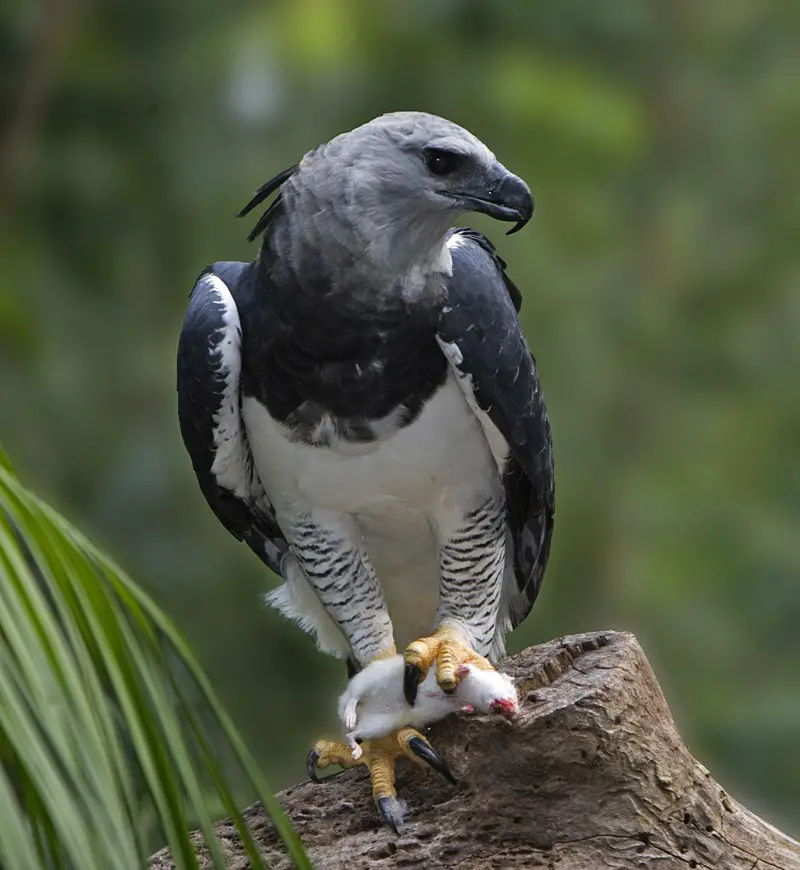
The Harpy Eagle is a magnificent bird of prey found in the tropical forests of Central and South America. It is the largest eagle on Earth, possessing an impressive wingspan that can reach up to 7 feet across.
Its powerful talons are its most distinguishing feature, being able to grasp even large animals such as monkeys or sloths with ease.
The majestic raptor has slate-gray feathers on its back and head which contrast against white undersides and yellow legs.
These birds live alone for much of their life but will come together during breeding season when they construct elaborate nests high off the ground in tall trees.
People have long been fascinated by this species’ impressive size and strength—it truly deserves its nickname as “the lord of skies”.Scientific classification:
| Kingdom | Animalia |
| Phylum | Chordata |
| Class | Aves |
| Order | Accipitriformes |
| Family | Accipitridae |
| Subfamily | Harpiinae |
| Genus | Harpia Vieillot, 1816 |
| Species | H. harpyja |
2. Resplendent Quetzal
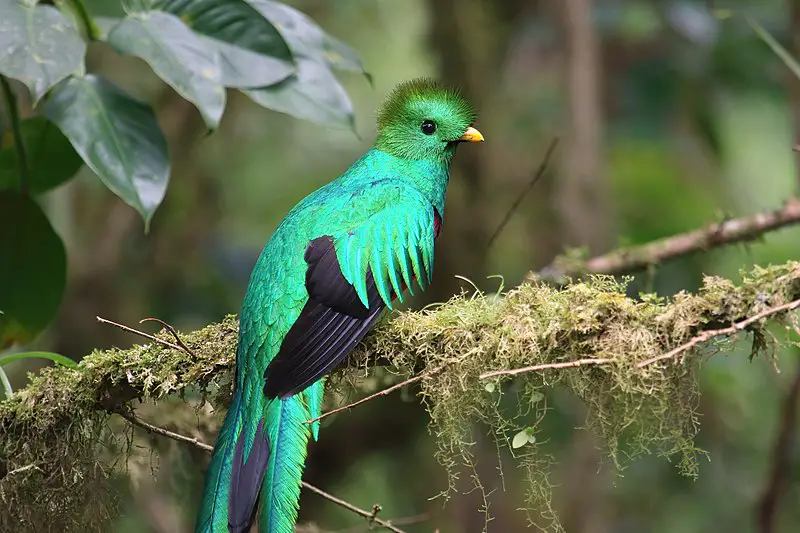
The resplendent quetzal is a beautiful and vibrant bird found in Central America. It belongs to the family Trogonidae, which includes birds like trogons and motmots.
This species of quetzal has two recognized subspecies: P. mocinno and P. costaricensis, both living in tropical forests such as montane cloud forests.
They are omnivores, typically eating fruits from various plants along with insects, lizards or eggs when available.
The male’s plumage is particularly striking with its multi-colored feathers ranging from green to blue to red that gives it its namesake “resplendence” look.
This coloration comes at a price for males because their bright colors make them more visible predators than females who have duller brown coloring instead.
Regardless of gender though all members of this species demonstrate great agility in flight due to their long tails which help stabilize them even through tight turns.Scientific classification:
| Kingdom | Animalia |
| Phylum | Chordata |
| Class | Aves |
| Order | Trogoniformes |
| Family | Trogonidae |
| Genus | Pharomachrus |
| Species | P. mocinno |
3. Antbird
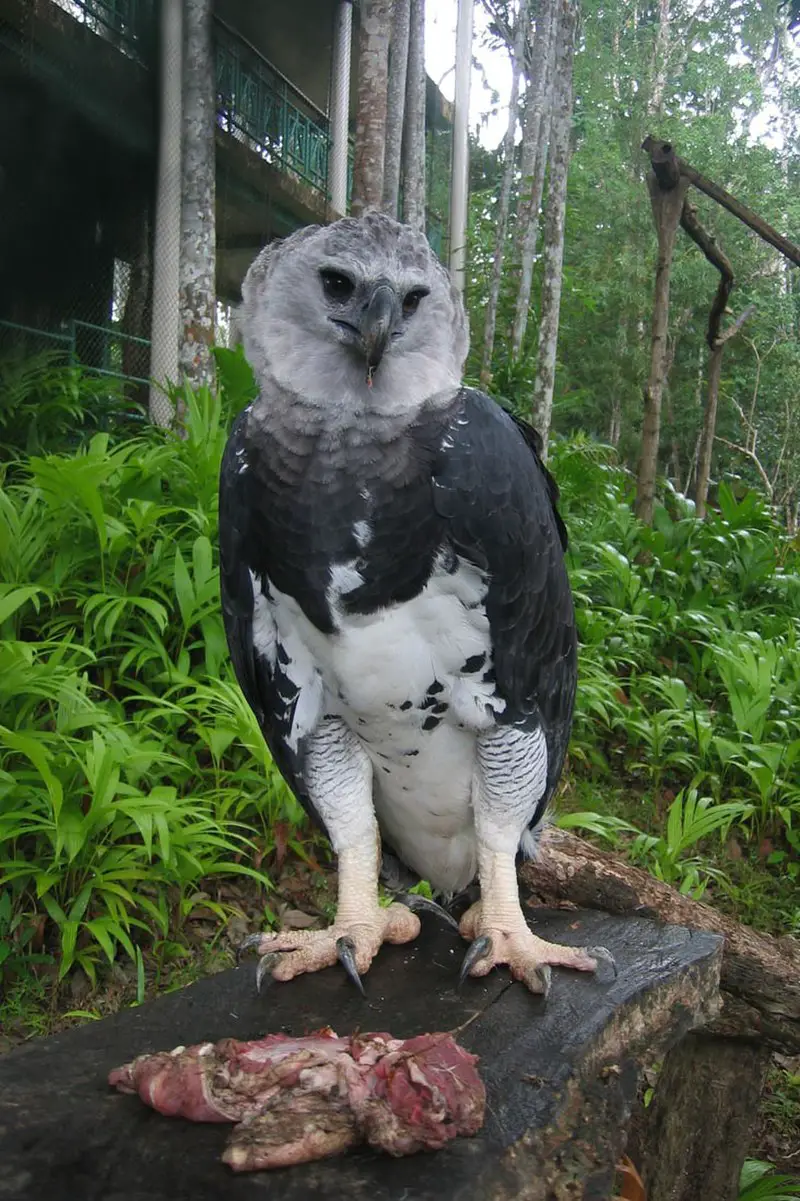
Antbirds are a large family of passerine birds found mainly in Central and South America. They range from very small to medium-sized, with the largest species being around 30 cm (12 inches) long.
Antbirds have round heads, short wings and tails, and strong legs for running on the ground.
Their plumage is typically dark brown or black with white markings; many species also have bright colors such as yellow or red on their throat or head.
The most characteristic feature of antbirds is their habit of following swarms of army ants while searching for insects disturbed by the ants’ movement – hence their name.
This behavior provides them with an easy source of food but it can be dangerous too; they often need to dodge predators that come after them as they scavenge through these insect clouds.
4. Spectacled Owl
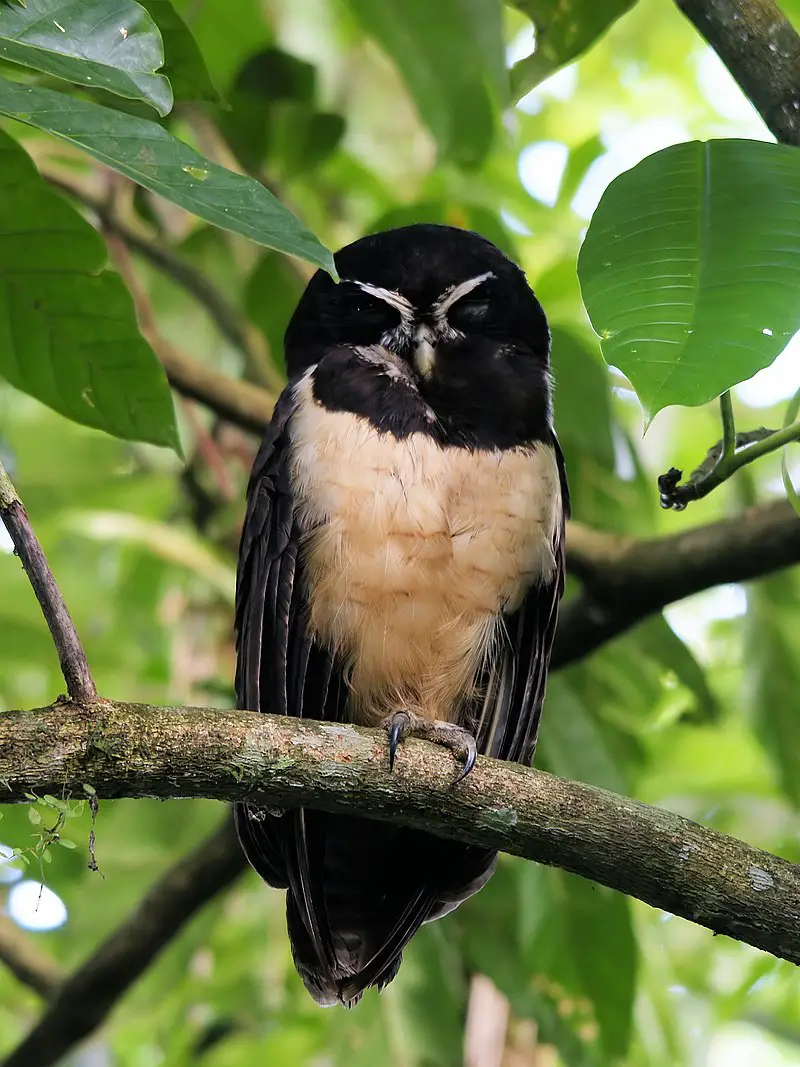
The Spectacled Owl is a large tropical owl that breeds in forests from southern Mexico, Trinidad and Central American countries to Southern Brazil, Paraguay and Argentina.
It has six subspecies with one of them sometimes considered as a separate species called the Short-Browed or Brown Spectacled Owl.
The bird’s body is covered by an array of feathers which are typically dark brown streaked with lighter shades marking its eyes like spectacles; this gives it its name.
Its call could be described as a series of hoots followed by shrieks making it easily distinguishable amongst other owls.
This nocturnal predator feeds mostly on small mammals such as mice while larger prey items include frogs, bats and even birds.Scientific classification:
| Kingdom | Animalia |
| Phylum | Chordata |
| Class | Aves |
| Order | Strigiformes |
| Family | Strigidae |
| Genus | Pulsatrix |
| Species | P. perspicillata |
Also Featured In: Birds That Live in the Jungle, Rainforest Birds You Should Know
5. Tropical Kingbird
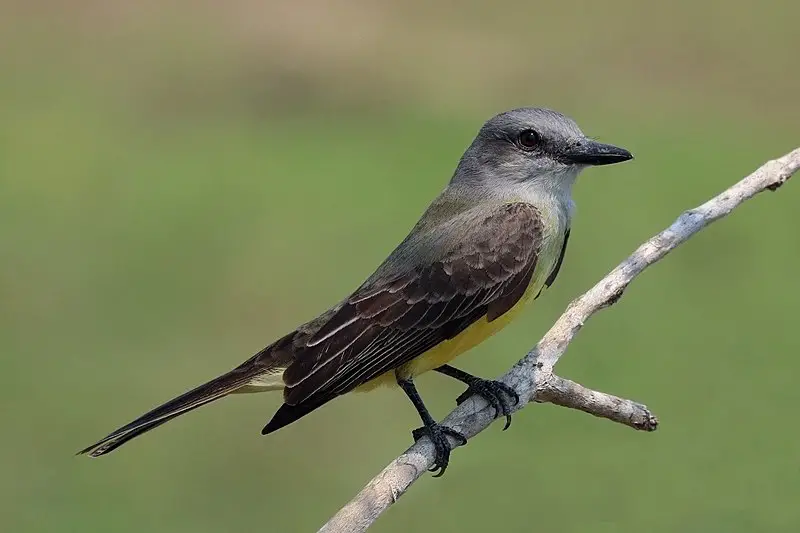
The Tropical Kingbird is an impressive bird, native to the Americas. It’s a large tyrant flycatcher that breeds in southern Arizona and Texas through Central America and down south as far as Argentina and Peru.
This species also lives on Trinidad & Tobago islands. During cold winter months, most of them migrate to warmer climates within its range.
They inhabit open areas such as fields or forests with scattered trees – but away from heavily wooded habitats.
In terms of diet, they mainly feed upon insects which are caught by hawking from perches or snatching up in flight; however it will occasionally eat fruits too.
The adult has grey-brown upperparts, darker wings edged with yellowish feathers plus a white breast band contrasting against pale orange underparts for both sexes.
A conspicuous black mask runs across their eyes completing this beautiful bird’s look.Scientific classification:
| Kingdom | Animalia |
| Phylum | Chordata |
| Class | Aves |
| Order | Passeriformes |
| Family | Tyrannidae |
| Genus | Tyrannus |
| Species | T. melancholicus |
6. Crimson-Backed Tanager
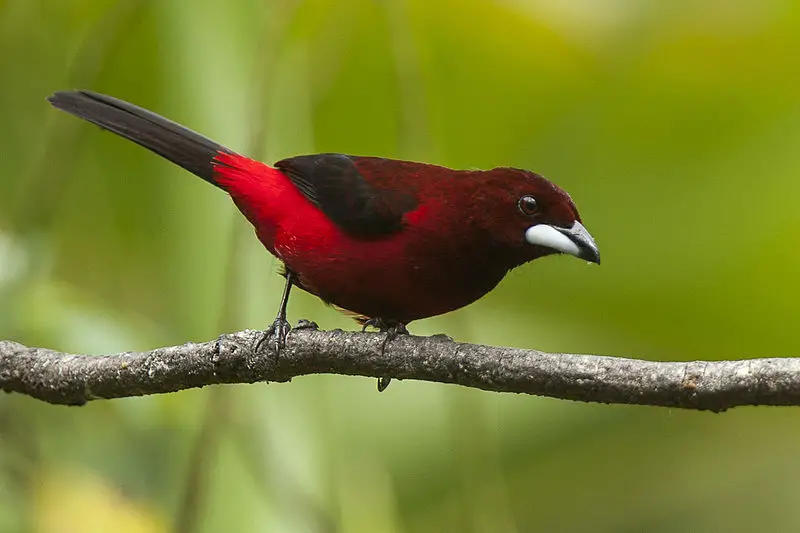
The Crimson-backed Tanager is a beautiful bird found in Colombia, Panama and Venezuela. It also has an introduced population in French Polynesia.
The tanager prefers to live in subtropical or tropical moist lowland forests as well as heavily degraded former forests.
In Panama it’s nicknamed “Sangre de Toro” which translates to “Blood of the Bull”. These brightly colored birds have crimson backs with black heads and yellow underparts that contrast nicely with their bright green wings and tail feathers.
They feed mainly on insects but are known to eat fruit occasionally too.
Overall they make for excellent additions to any backyard garden due to their vibrant colors, cheerful songs and friendly behavior towards other birds making them wonderful neighbors.Scientific classification:
| Kingdom | Animalia |
| Phylum | Chordata |
| Class | Aves |
| Order | Passeriformes |
| Family | Thraupidae |
| Genus | Ramphocelus |
| Species | R. dimidiatus |
7. Keel-Billed Toucan
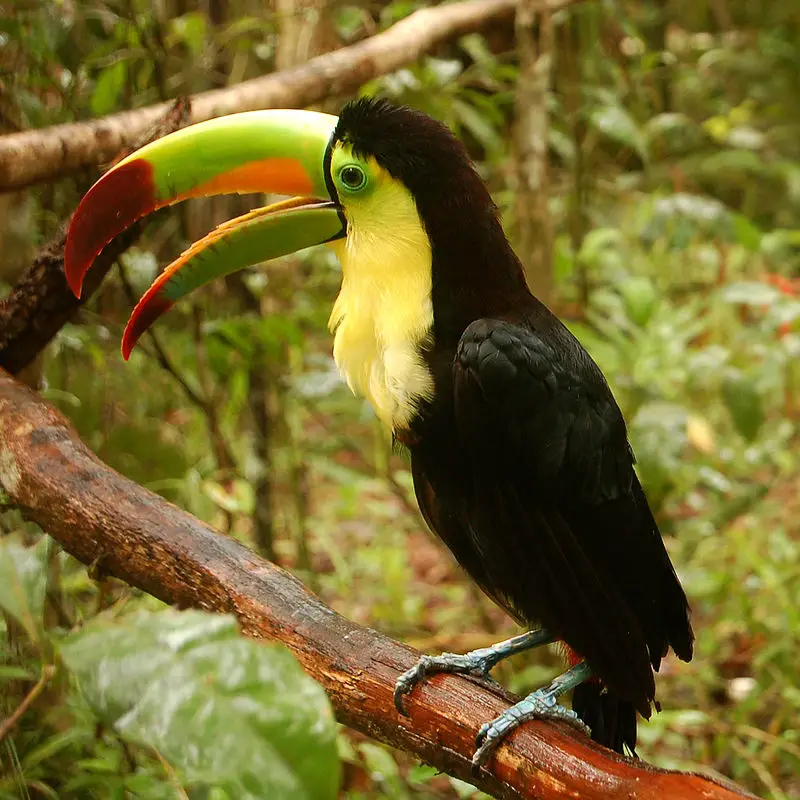
The Keel-billed Toucan is a vibrant Latin American bird from the toucan family and also serves as Belize’s national bird. They are found in tropical jungles stretching all the way from southern Mexico to Colombia.
They feed on fruits, seeds, insects, lizards and snakes – being omnivorous birds they eat pretty much anything.
These colourful creatures have an impressive beak with green upper parts of their bodies coupled with yellow lower halves.
The underside of their tail feathers are black while its tips remain white creating for quite a stunning display when flying or perched atop tree branches.Scientific classification:
| Kingdom | Animalia |
| Phylum | Chordata |
| Class | Aves |
| Order | Piciformes |
| Family | Ramphastidae |
| Genus | Ramphastos |
| Species | R. sulfuratus |
8. Laughing Falcon
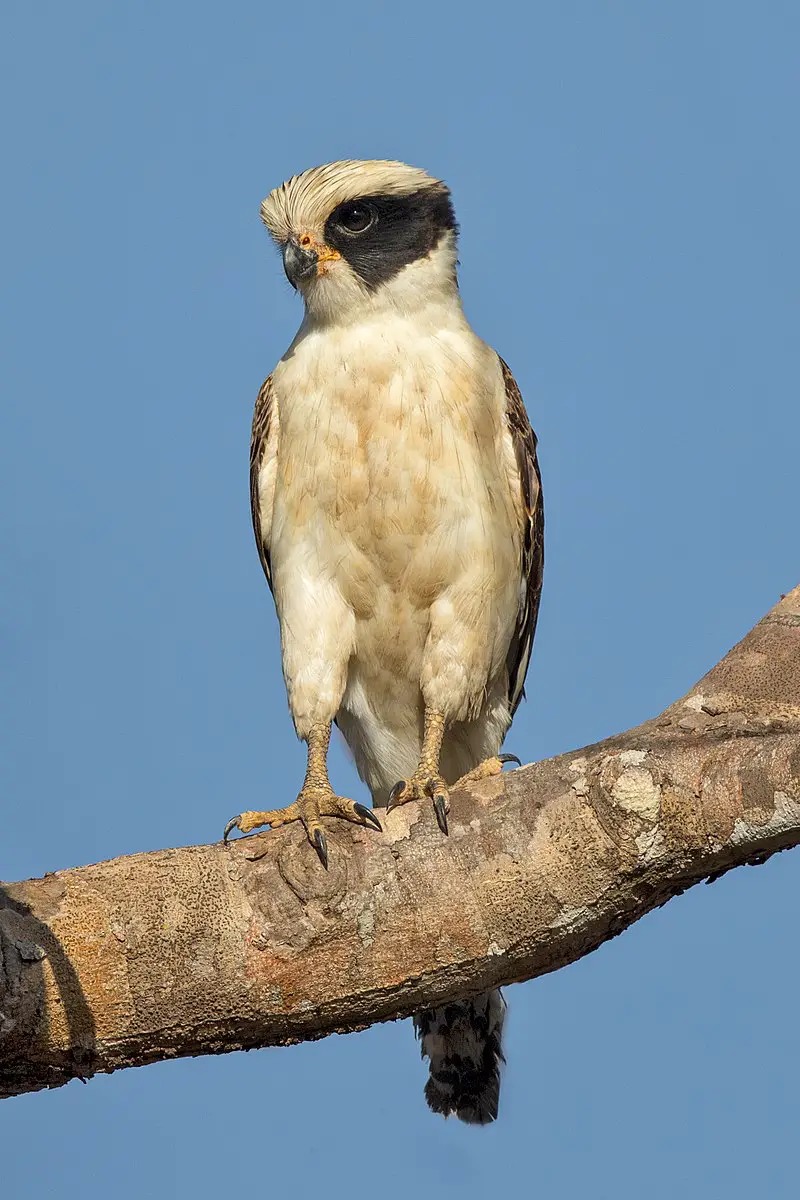
The Laughing Falcon is a medium-sized bird of prey belonging to the falcon family. It’s only member of its genus, Herpetotheres cachinnans, and got its name from it’s distinct loud voice.
This Neotropical species is known for being an expert snake eater. With sharp talons and powerful beak they are well equipped for hunting down snakes and lizards with ease.
Despite their fierce reputation they have a gentle side too; pairs usually mate for life while looking after their offspring together in harmony.
The Laughing Falcon should be admired rather than feared as this amazing creature has much more to offer than just hissing sound effects.Scientific classification:
| Kingdom | Animalia |
| Phylum | Chordata |
| Class | Aves |
| Order | Falconiformes |
| Family | Falconidae |
| Subfamily | Herpetotherinae |
| Genus | Herpetotheres Vieillot, 1817 |
| Species | H. cachinnans |
9. Black-Crowned Antpitta
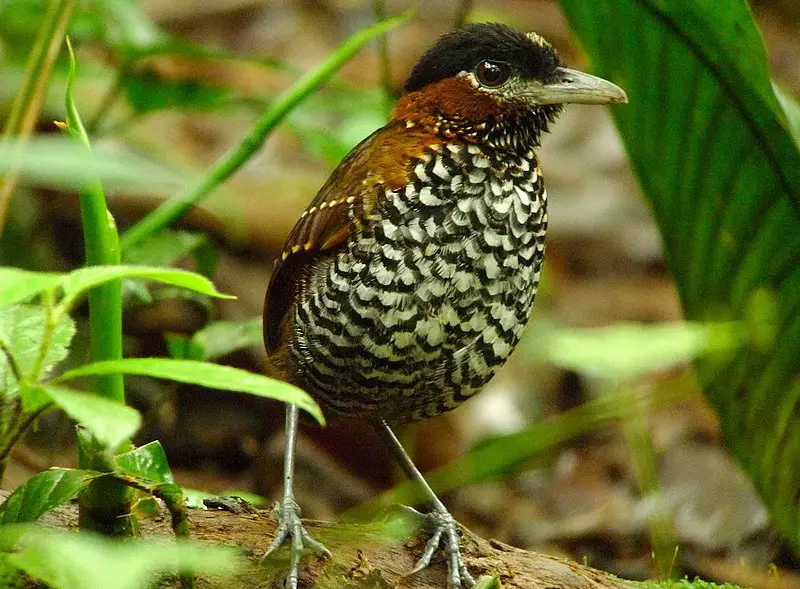
The black-crowned antpitta is a small bird that inhabits moist foothill forests in Colombia, Costa Rica, and Panama. With its distinctive black crown and gray breast it stands out from other species of the gnateater family within which it belongs.
This species was formerly classified as an antthrush but now resides in its own genus – Pittasoma. It has adapted to living near streams where it can forage for invertebrates on the ground or low vegetation with ease.
The call of this little bird is often heard echoing through forested areas at dawn or dusk when they are most active during their search for food.
Conservation efforts have been focused on protecting these habitats so future generations may continue to enjoy hearing their unique song throughout Central America’s tropical forests.Scientific classification:
| Kingdom | Animalia |
| Phylum | Chordata |
| Class | Aves |
| Order | Passeriformes |
| Family | Conopophagidae |
| Genus | Pittasoma |
| Species | P. michleri |
10. Tody Motmot
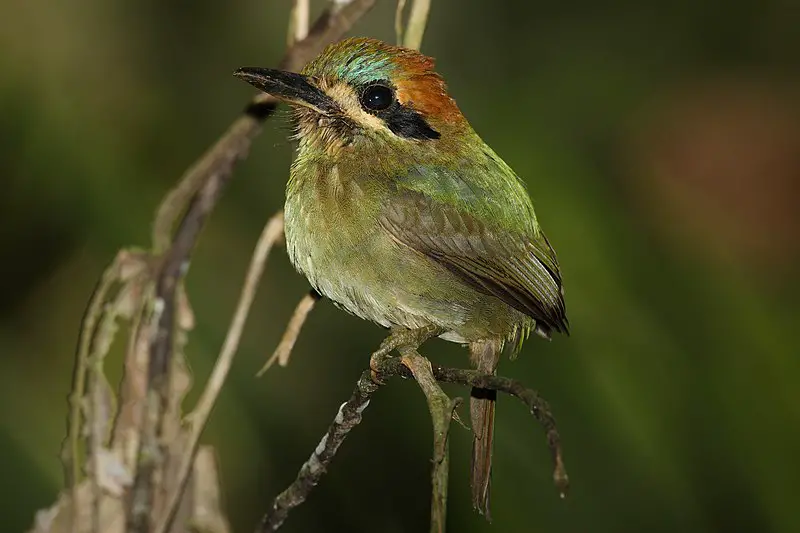
The Tody Motmot is a species of passerine bird belonging to the family Momotidae. It inhabits parts of Central America, ranging from Belize to Panama.
Distinguished by its bright colors and unique tail feathers, this bird stands out among its feathered friends in the tropical forest canopy.
Its most notable feature are two long central tail feathers with green iridescence which can be spread fan-like or kept close together for courtship displays or protection against predators.
The three subspecies differ slightly in size and plumage coloration patterns; however all share short rounded wings adapted for maneuvering through dense vegetation as they search for insects, small reptiles and amphibians on which they feed during their daily activities.
So if you ever find yourself exploring these lush rainforests take some time to observe one of nature’s true gems -the beautiful Tody Motmot.Scientific classification:
| Kingdom | Animalia |
| Phylum | Chordata |
| Class | Aves |
| Order | Coraciiformes |
| Family | Momotidae |
| Genus | Hylomanes Lichtenstein, MHC, 1839 |
| Species | H. momotula |
11. Stripe-Cheeked Woodpecker
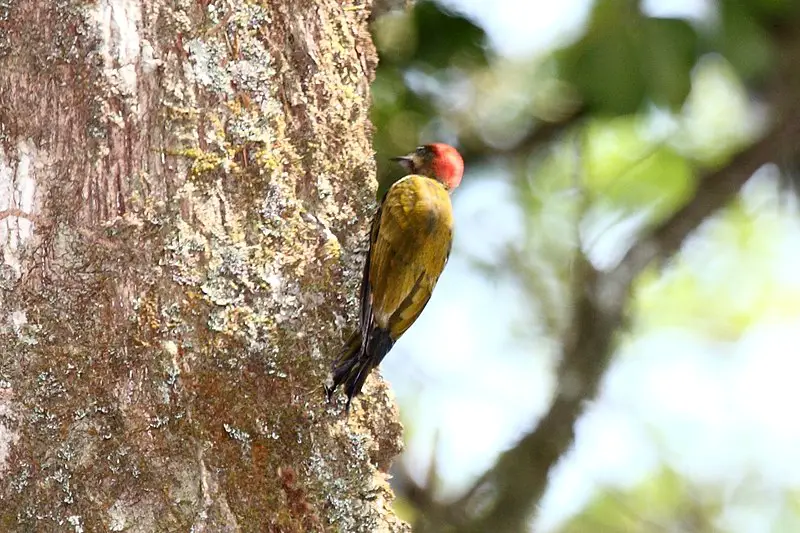
The Stripe-cheeked woodpecker is a species of bird native to Panama. Both males and females are an orangish brown above, with an olive barred yellow rump, chest and throat marked by white spots.
The crown, nape and moustachial region on males is bright red while females have dark gray heads instead.
This bird’s most distinctive feature however is its lower cheek which has a distinct white streak that gives it its name.
In addition to being found in the forests of Panama this species can also be seen at the edges of agricultural fields where they feed mainly on insects such as ants and beetles amongst other things like fruit or sap from trees.Scientific classification:
| Kingdom | Animalia |
| Phylum | Chordata |
| Class | Aves |
| Order | Piciformes |
| Family | Picidae |
| Genus | Piculus |
| Species | P. callopterus |
12. Bay-Headed Tanager
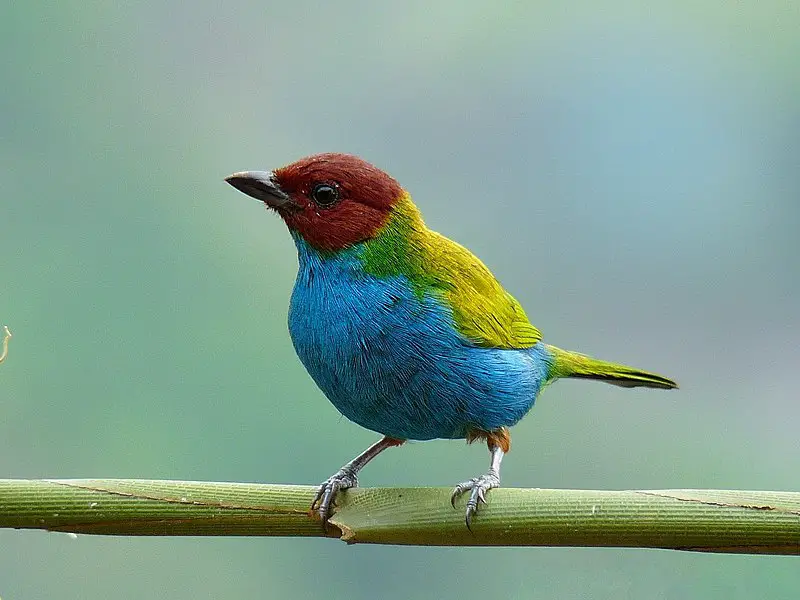
The Bay-headed Tanager is a medium-sized passerine bird that can be found in parts of Costa Rica, Panama, South America and even Trinidad. It was first described by Swedish naturalist Carl Linnaeus back in 1758.
This tanager has an olive green head with black streaks on its wings and pale blue breast along with dark bluish grey upperparts.
They feed primarily on fruits but also eat insects such as flies and caterpillars when available.
The male bay-headed tanagers are more brightly coloured than females; they have yellowish heads while the female’s are duller or brownish colouring.
These birds usually live alone or form small flocks during winter months to migrate southward for breeding season around April to September depending upon location.Scientific classification:
| Kingdom | Animalia |
| Phylum | Chordata |
| Class | Aves |
| Order | Passeriformes |
| Family | Thraupidae |
| Genus | Tangara |
| Species | T. gyrola |
13. Rufous Motmot
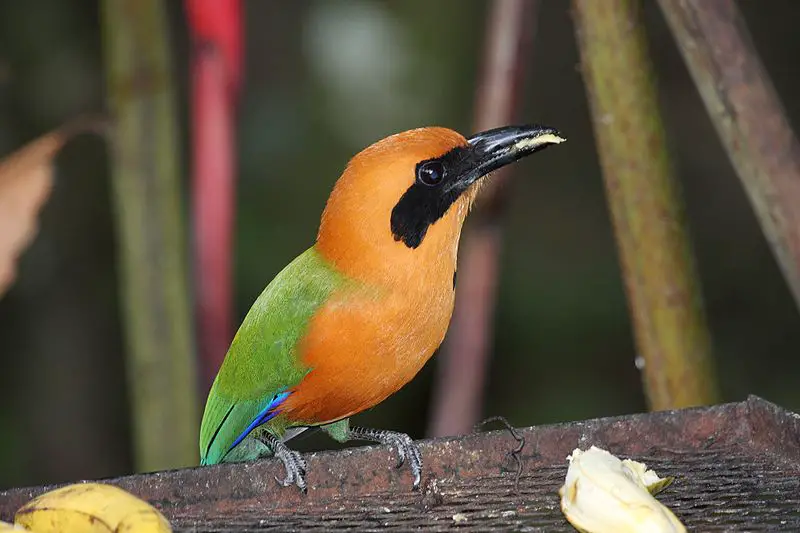
The Rufous Motmot is a beautiful bird found across Central and South America. It belongs to the Momotidae family, along with its close relative, the rufous-capped motmot.
This colorful species has dark blue wings and tail feathers, brownish body plumage, a bright orange breast patch and white tips on its long middle tail feathers. Its distinctive call sounds like ‘who who’ or ‘hoot hoot.’
These birds are monogamous during breeding season but can also be seen in groups of up to ten individuals foraging together for food such as insects, scorpions and small lizards.
They build their nests near streams in tunnels they excavate themselves using their robust bills full of bristles which gives them an impressive appearance when they emerge from inside these underground chambers.Scientific classification:
| Kingdom | Animalia |
| Phylum | Chordata |
| Class | Aves |
| Order | Coraciiformes |
| Family | Momotidae |
| Genus | Baryphthengus |
| Species | B. martii |
14. Barred Puffbird
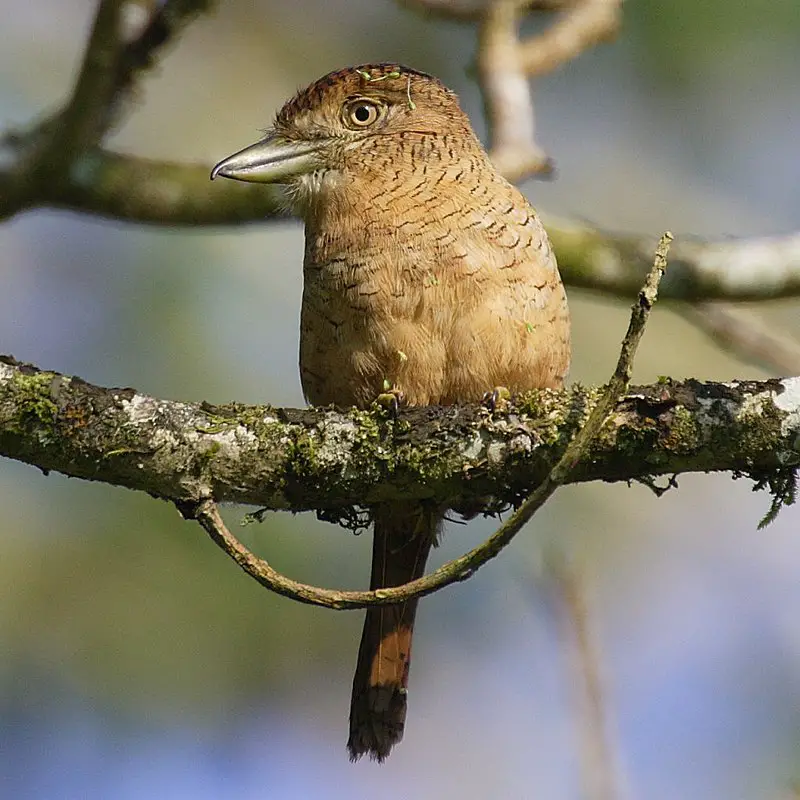
The Barred Puffbird is a species of bird belonging to the family Bucconidae, which includes puffbirds, nunlets and nunbirds. This unique species can be found in Panama, Colombia and Ecuador.
It was previously placed under genus Ecchaunornis but has since been returned to Nystalus.
The Barred Puffbird stands out from other birds due to its distinct white barring on its neck, back and belly with an overall brownish-yellow sheen; it also shows off two long tufts above each eye.
Its diet consists mainly of insects as well as small fruits like berries or figs occasionally thrown into the mix for diversity. Although this amazing creature may not make much noise around you – their presence in your backyard will certainly bring some colour.Scientific classification:
| Kingdom | Animalia |
| Phylum | Chordata |
| Class | Aves |
| Order | Piciformes |
| Family | Bucconidae |
| Genus | Nystalus |
| Species | N. radiatus |
15. Dusky-Backed Jacamar
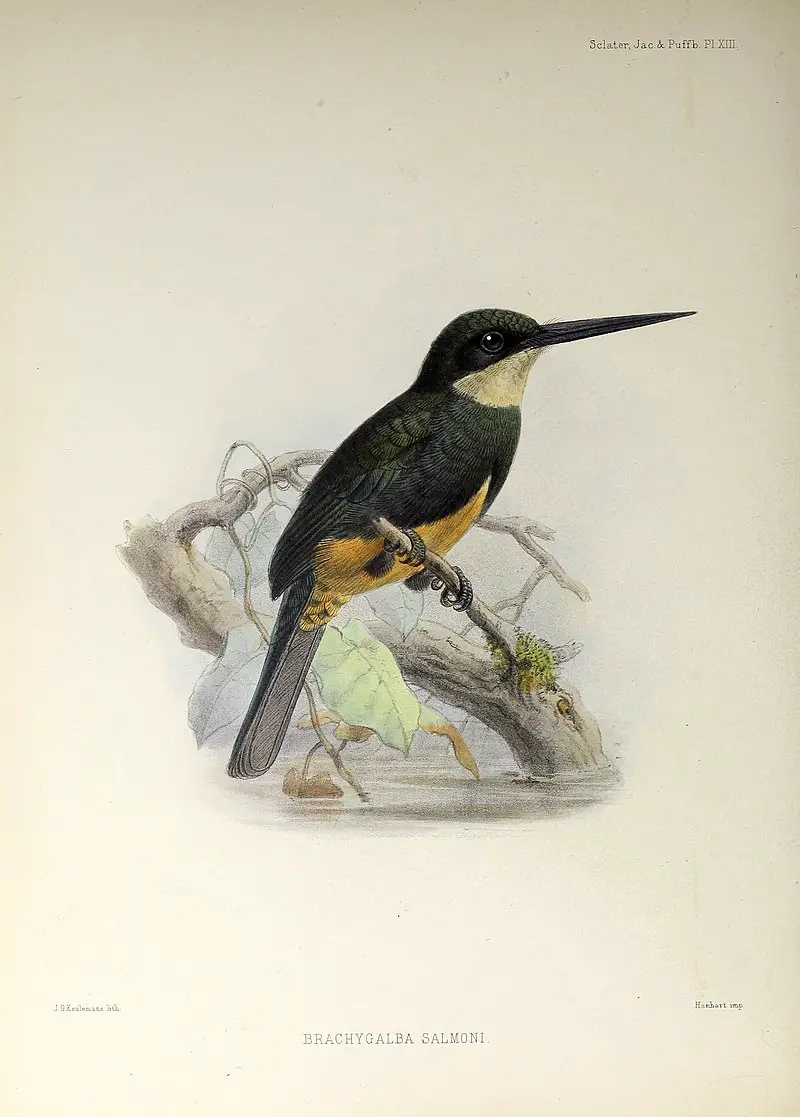
The Dusky-backed Jacamar is a species of bird belonging to the Galbulidae family. It can be found in Colombia and Panama, where it stands out from other jacamars due its monotypic nature.
It measures 16.5 to 18 cm long and males weigh about 18.5 g; females are slightly smaller but their weight remains unknown for now.
This bird has an overall dark brown colouration with a blackish back, wings, tail and nape while its belly tends to have creamy tones on some specimens; there’s also some pale yellow spots around the eyes which contrast beautifully against its plumage colours.
They’re quite shy birds that inhabit humid tropical forests close by rivers or water sources so they can feed mainly on flying insects like dragonflies or beetles as well as small frogs if given the chance – this behaviour contributes to keep insect populations under control within these ecosystems.Scientific classification:
| Kingdom | Animalia |
| Phylum | Chordata |
| Class | Aves |
| Order | Piciformes |
| Family | Galbulidae |
| Genus | Brachygalba |
| Species | B. salmoni |
16. Red-Capped Manakin
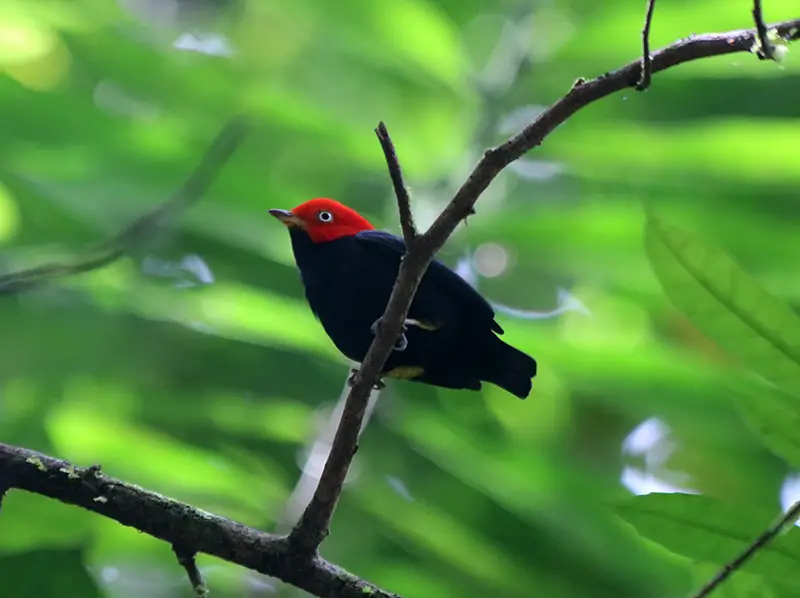
The red-capped manakin is a species of bird found in Central and South America. It has distinctive red feathers on its head that contrast with the otherwise dark plumage, giving it an unmistakable appearance.
The male is particularly noteworthy for his courtship display, which involves rapidly shuffling backwards along a branch while making loud calls to attract potential mates.
This behaviour makes them highly sought after by birdwatchers who come from far and wide to observe this unique ritual.
In addition to their fascinating courtship behavior, they are also important seed dispersers throughout their range which helps maintain healthy ecosystems in these areas.
Despite being relatively common across much of its range, habitat loss due to deforestation has left some populations vulnerable and conservation efforts need continued attention if we want future generations of people have the chance to witness these remarkable birds performing their captivating dance displays.Scientific classification:
| Kingdom | Animalia |
| Phylum | Chordata |
| Class | Aves |
| Order | Passeriformes |
| Family | Pipridae |
| Genus | Ceratopipra |
| Species | C. mentalis |
17. Yellow-Eared Toucanet
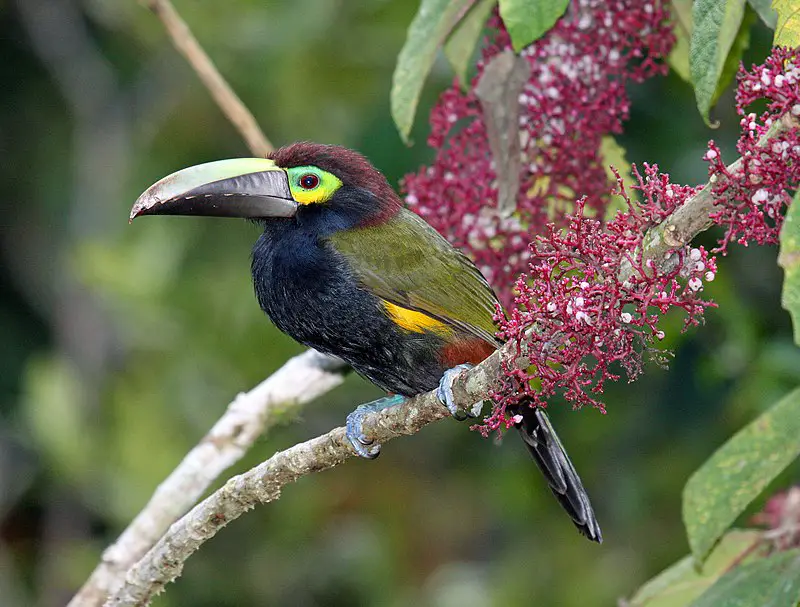
The Yellow-eared toucanet is a near passerine bird that ranges from Honduras to Ecuador. It has an impressive length of 36 – 38 cm and weighs 175 – 225 g, making it one of the smaller members of its Ramphastidae family.
This species may be more closely related to mountain toucans than other birds in its genus Selenidera as well.
The yellow-eared toucanet is easily recognizable by its striking yellow ear patch and bright blue throat feathers which contrast against their black plumage throughout much of their body.
They are also known for their loud vocalizations, often heard during mating season or when communicating with each other..Scientific classification:
| Kingdom | Animalia |
| Phylum | Chordata |
| Class | Aves |
| Order | Piciformes |
| Family | Ramphastidae |
| Genus | Selenidera |
| Species | S. spectabilis |
18. Rufous-Tailed Jacamar
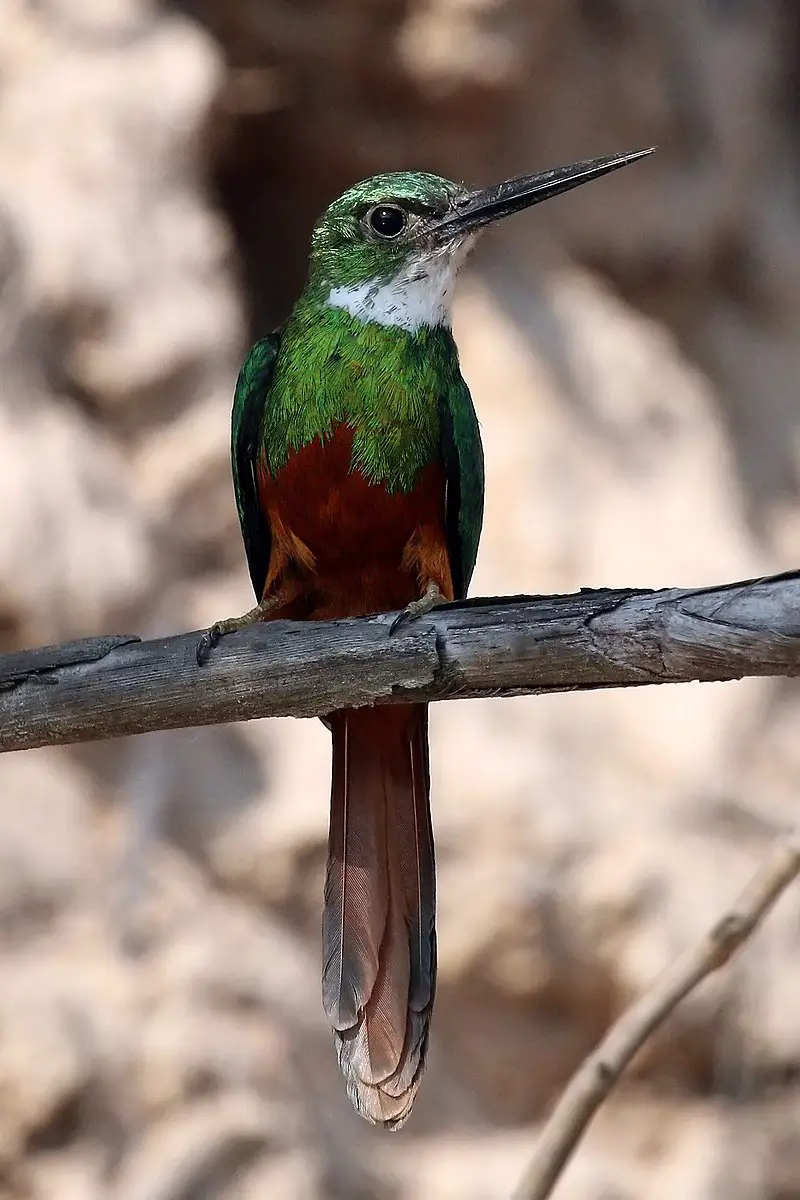
The Rufous-tailed Jacamar is a near-passerine bird that lives in tropical regions of Mexico, Central and South America. It’s about 25 cm long with a 5 cm black bill and its distinguishing feature is its rufous coloured tail feathers.
Its body has an elegant shape with bright plumage consisting of mainly green hues on the head, neck and wings; whilst it’s chest is white with yellow speckles.
These birds feed mostly on insects which they catch midair or from branches using their long bills to pluck them out.
They build nests made from twigs lined by mosses in tree cavities where they lay two eggs at once during breeding season between April – August each year.Scientific classification:
| Kingdom | Animalia |
| Phylum | Chordata |
| Class | Aves |
| Order | Piciformes |
| Family | Galbulidae |
| Genus | Galbula |
| Species | G. ruficauda |
19. Ornate Hawk-Eagle
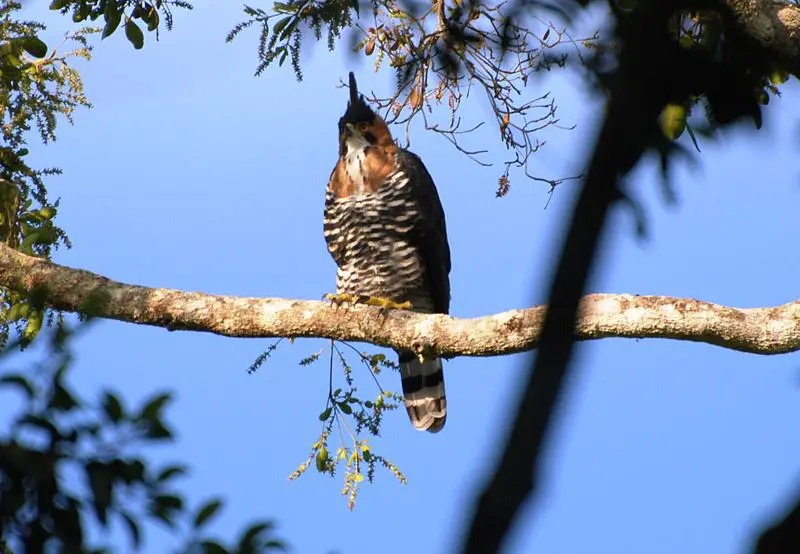
The Ornate Hawk-Eagle is a magnificent bird of prey that hails from the tropical Americas. With its striking mocha brown and white feathers, this eagle stands out among other birds in its family Accipitridae.
Male specimens are especially stunning with bold cream and black stripes along their back as well as a unique crest on top of their heads.
They have powerful talons which they use to hunt small mammals like rabbits or monkeys, but also feed upon smaller birds and reptiles found near forests or marshes where they typically reside.
This majestic raptor may sometimes be seen soaring gracefully through the sky above its habitats, showing off for onlookers below.Scientific classification:
| Kingdom | Animalia |
| Phylum | Chordata |
| Class | Aves |
| Order | Accipitriformes |
| Family | Accipitridae |
| Genus | Spizaetus |
| Species | S. ornatus |
20. Blue-Gray Tanager
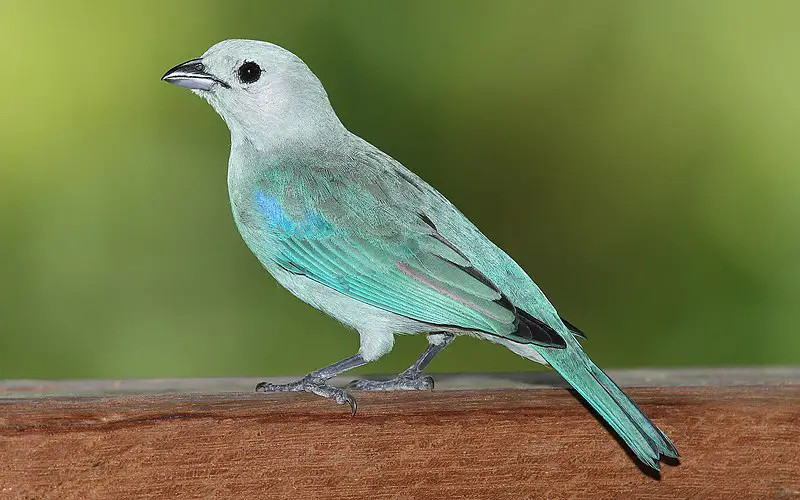
The blue-gray tanager is a medium-sized songbird native to South America, ranging from Mexico all the way down to northern Brazil and Bolivia.
It has been introduced in Lima, Peru as well as Trinidad and Tobago where it is called “blue jean”.
This species was first described by French zoologist Mathurin Jacques Brisson in 1760. The bird’s plumage features hues of gray, blue, yellow and green creating an attractive contrast against its white belly.
Its diet consists mainly of insects like beetles but also fruits such as figs are known to be part of their daily nutrition.
Blue-gray tanagers usually inhabit humid forests near running watercourses making them relatively easy to spot while they search for food on tree branches or foliage cover around streams during the day time.Scientific classification:
| Kingdom | Animalia |
| Phylum | Chordata |
| Class | Aves |
| Order | Passeriformes |
| Family | Thraupidae |
| Genus | Thraupis |
| Species | T. episcopus |
21. Crowned Woodnymph
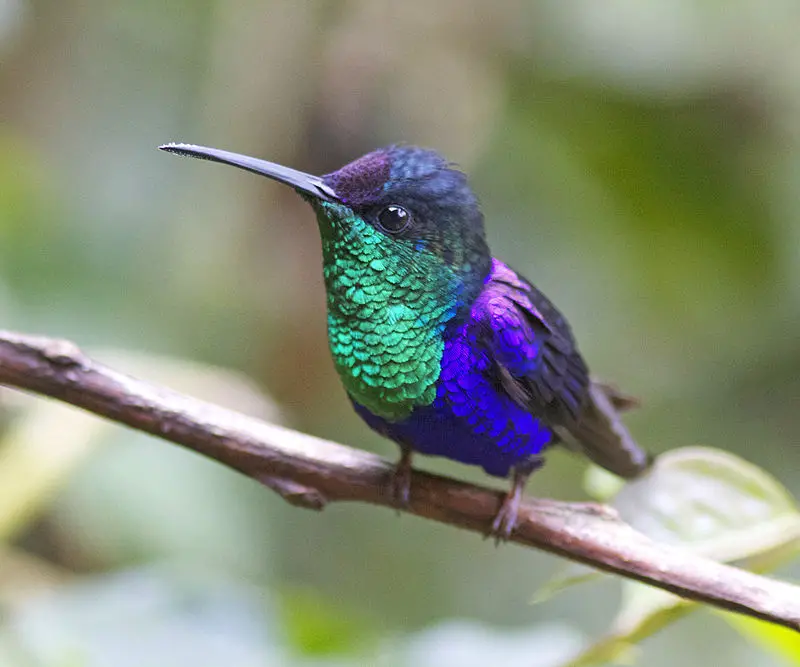
The Crowned Woodnymph is a species of hummingbird that can be found in the Americas, from Belize and Guatemala to northern Peru. It has an emerald-green body with a white underbelly.
The most striking feature of this bird is its violet crown, giving it its name.
It also has two small black marks on each side of its neck as well as multiple iridescent feathers covering much of its back.
This vibrant creature typically feeds on nectar from flowers and insects such as spiders and moths which they catch mid-flight using their long bills or tongues.
All these features make them one of the most beautiful birds living in Central America rainforests today.Scientific classification:
| Kingdom | Animalia |
| Phylum | Chordata |
| Class | Aves |
| Order | Apodiformes |
| Family | Trochilidae |
| Genus | Thalurania |
| Species | T. colombica |
22. Thick-Billed Euphonia
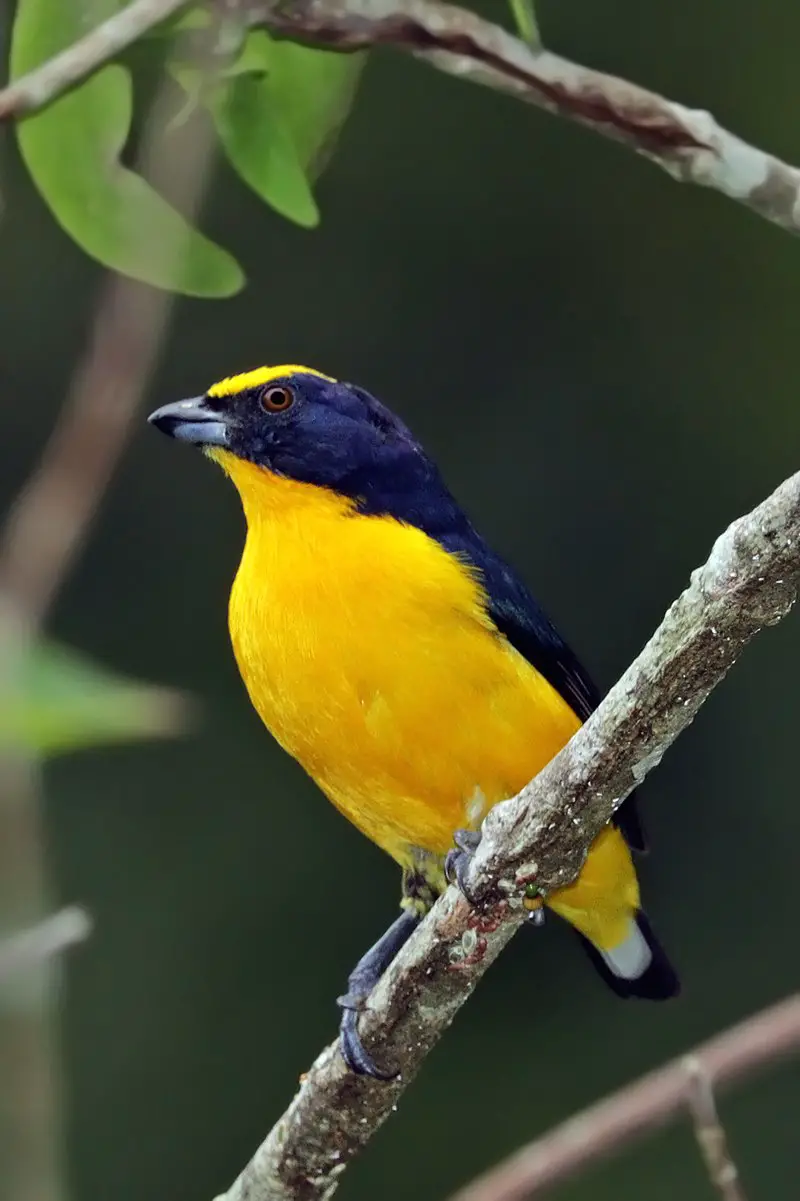
The Thick-billed Euphonia is a small bird native to Central and South America. It measures 10 cm in length, with bright yellow underparts that contrast sharply with its dark blue-black upper parts and yellow crown patch on the head.
The male of this species has an additional terminal white patch at the undertail. This attractive bird typically inhabits forest edges, woodland areas and savannas where it feeds on insects, fruit and nectar from flowers.
Its call is described as a sharp chirping sound made up of several notes each ending abruptly.
As their numbers are decreasing due to deforestation or capture for trade purposes they have become vulnerable across some parts of their range; conservation efforts must be put into place if we wish to keep them around for many more years.Scientific classification:
| Kingdom | Animalia |
| Phylum | Chordata |
| Class | Aves |
| Order | Passeriformes |
| Family | Fringillidae |
| Subfamily | Euphoniinae |
| Genus | Euphonia |
| Species | E. laniirostris |
23. Rufous-Vented Ground Cuckoo
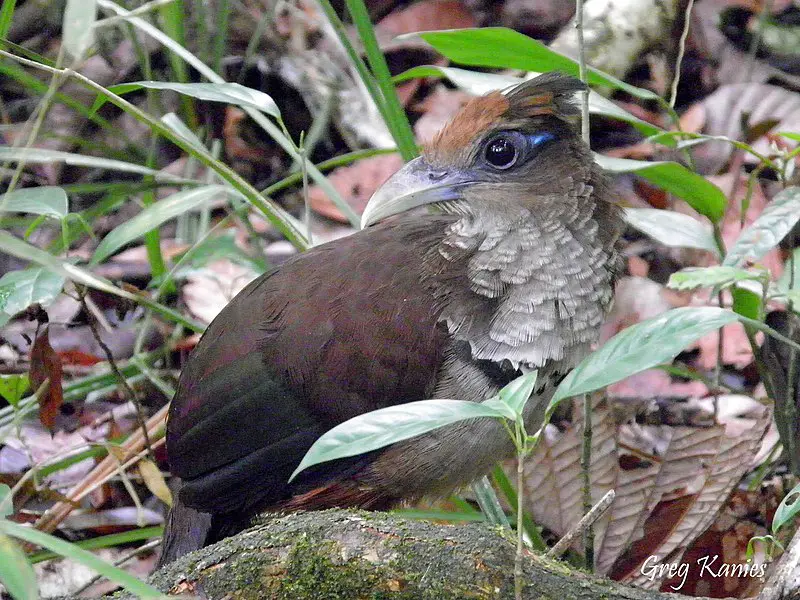
The Rufous-vented Ground Cuckoo is a beautiful Vulnerable species of cuckoo found in Bolivia, Brazil, Colombia and other South American countries. It belongs to the Neomorphini tribe of subfamily Crotophaginae.
Six different subspecies are recognised for this bird which has an unmistakable loud call that can be heard from far away distances.
Its plumage is mainly brown with white streaks on its back and it has a large rufous band across its vent area giving it its name ‘Rufous-vented’.
The diet consists mostly of insects such as grasshoppers as well as small lizards and frogs eggs sometimes too.
This ground dwelling cuckoos live primarily in humid tropical forests but they also inhabit secondary forest areas where there is plenty vegetation cover available to them during their search for food items or while trying to hide from potential predators like hawks or snakes.Scientific classification:
| Kingdom | Animalia |
| Phylum | Chordata |
| Class | Aves |
| Order | Cuculiformes |
| Family | Cuculidae |
| Genus | Neomorphus |
| Species | N. geoffroyi |
24. Rufous-Tailed Hummingbird
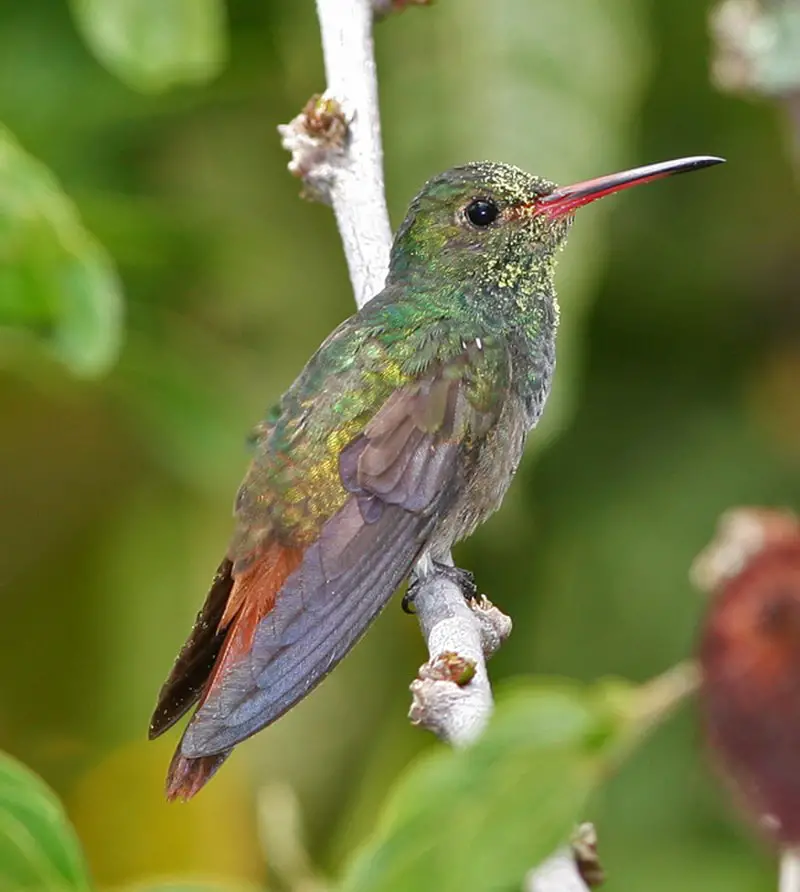
The rufous-tailed hummingbird is a medium-sized bird that belongs to the Trochilini tribe of subfamily Trochilinae. It can be found in east-central Mexico, Central America, Colombia, Ecuador and Venezuela.
This species was formally described back in 1833 by Mexican naturalist Pablo de La Llave who placed it in the genus Trochlilus and gave it its scientific name Amazilia tzacatl.
Its body has a brownish color with an orangey tail which helps distinguish it from other species.
The male’s throat also features bright blue tones on top of its light green feathers creating an eyecatching look when seen up close.
These birds feed mainly on nectar but will sometimes hunt for small insects as well; they are capable of flying at speeds reaching up to 34 mph.Scientific classification:
| Kingdom | Animalia |
| Phylum | Chordata |
| Class | Aves |
| Order | Apodiformes |
| Family | Trochilidae |
| Genus | Amazilia |
| Species | A. tzacatl |
25. Northern Jacana
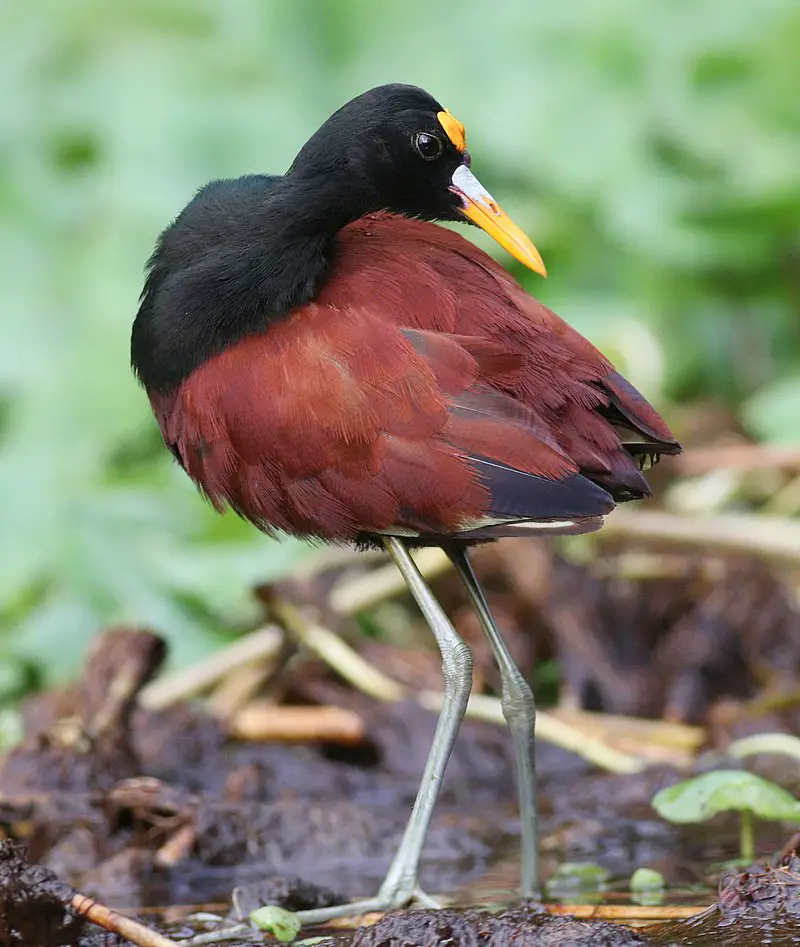
The Northern Jacana is a wading bird native to Mexico, Panama, Cuba, Jamaica and Hispaniola. It can also be found in Texas as a resident breeder or on rare occasions in Arizona as a vagrant.
This species of wetland birds are easily identified by their immense size and large feet with long toes that help them walk atop floating vegetation while searching for food.
Their upperparts have black feathers streaked with white whilst its underparts display brown plumage marked by yellowish spots near the wingtips.
They feed primarily on insects but will also eat other aquatic invertebrates like crustaceans or mollusks when available.
The female builds an untidy nest made from leaves close to water so she can quickly escape predators if needed.Scientific classification:
| Kingdom | Animalia |
| Phylum | Chordata |
| Class | Aves |
| Order | Charadriiformes |
| Family | Jacanidae |
| Genus | Jacana |
| Species | J. spinosa |
26. Neotropic Cormorant
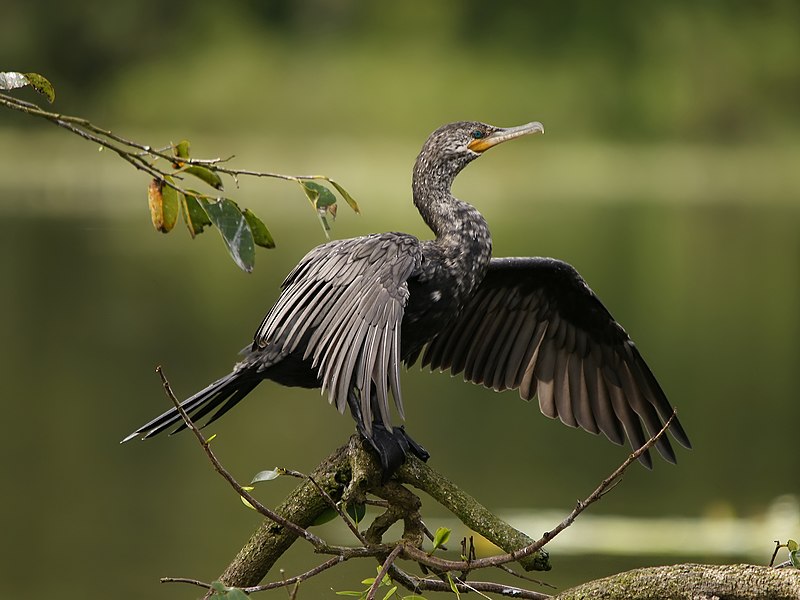
The Neotropic Cormorant, also known as the Olivaceous Cormorant, is a medium-sized bird found in tropical and subtropical regions of Central America, South America and the United States.
It can be identified by its black body with bright yellow facial skin on both sides of its large bill. The tail feathers are short and squared off at the tip.
This species breeds mainly on coasts but will sometimes nest inland near rivers or lakes during certain parts of their life cycle.
They feed mostly on small fish caught while diving underwater but can also eat crustaceans, amphibians and insects.
These birds roost in trees at night to keep safe from predators like foxes which prey upon them when they sleep close to water sources during daylight hours.Scientific classification:
| Kingdom | Animalia |
| Phylum | Chordata |
| Class | Aves |
| Order | Suliformes |
| Family | Phalacrocoracidae |
| Genus | Nannopterum |
| Species | N. brasilianum |
27. Fasciated Antshrike
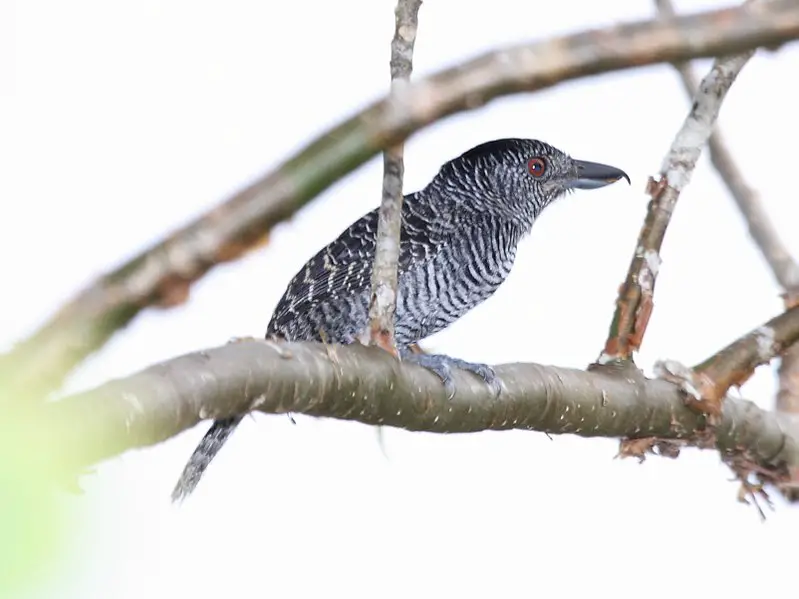
The Fasciated Antshrike is a species of bird in the antbird family Thamnophilidae that is found from Central to Southern America.
This species has very close ties with the Bamboo Antshrike, and until recently they were considered to be one and the same.
Despite their similar range, these two birds are now viewed as separate entities due to some minor differences between them.
The Fasciated Antshrike can usually be identified by its white breast band and brownish-gray back feathers which contrast nicely against its black wings and tail plumage.
Its bright yellow eyes also stand out amongst its other features making it easy for observers to spot this unique looking bird.Scientific classification:
| Kingdom | Animalia |
| Phylum | Chordata |
| Class | Aves |
| Order | Passeriformes |
| Family | Thamnophilidae |
| Genus | Cymbilaimus |
| Species | C. lineatus |
28. Barred Antshrike
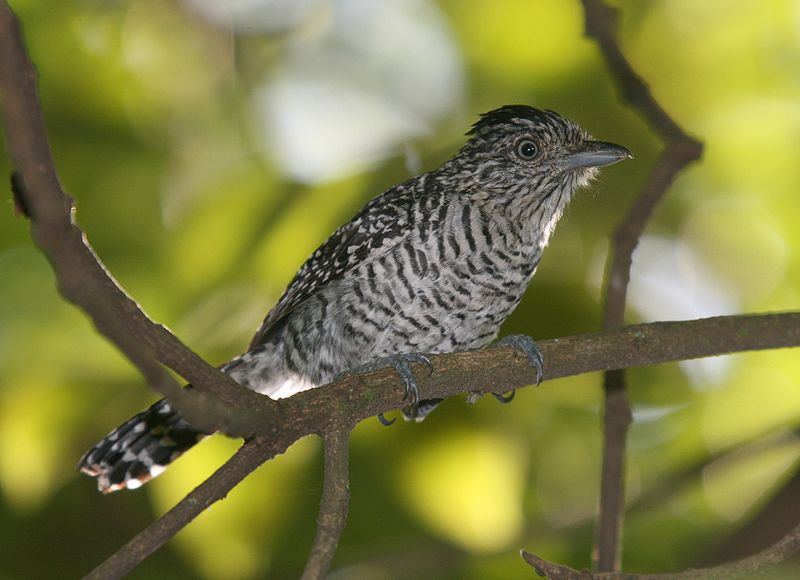
The Barred Antshrike is a beautiful bird belonging to the antbird family. It has an amazing range, being found in Mexico, Central America, Trinidad and Tobago as well as most of South America east of the Andes.
Even southern Texas has one accepted record. This small passerine can be spotted inhabiting wooded habitats that may consist of both dry and humid forests or even plantations with trees.
Its plumage consists mainly of black barring on its chestnut back along with white stripes on its wings giving it a unique look in flight.
Despite their shy nature they are quite vocal during breeding season when males sing from high perches for courtship displays; this is also when you’re likely to spot them at best.Scientific classification:
| Kingdom | Animalia |
| Phylum | Chordata |
| Class | Aves |
| Order | Passeriformes |
| Family | Thamnophilidae |
| Genus | Thamnophilus |
| Species | T. doliatus |
29. Black-Throated Trogon
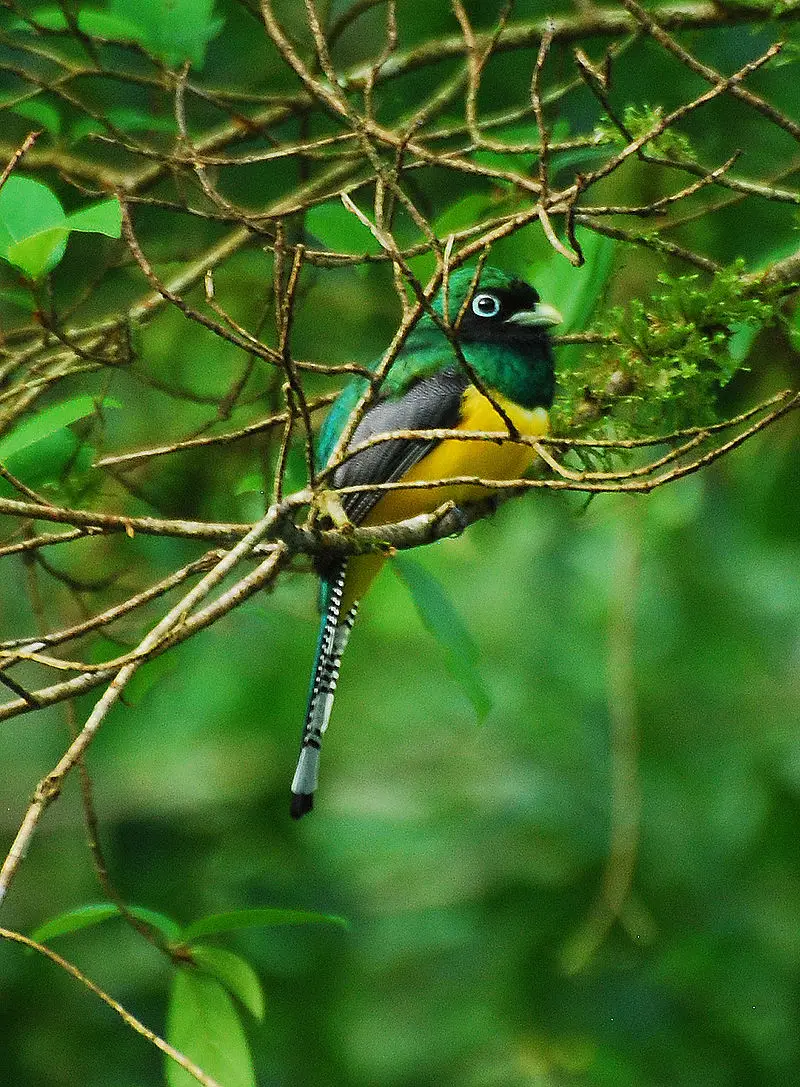
The Black-throated Trogon is a unique bird belonging to the trogon family. It can be found in lowlands from Honduras southwards till Ecuador and northern Argentina.
Its features include black throat, yellow belly, red breast and long tail with white spots on it.
The German naturalist described this species in 1788 as ‘Trogon rufus’ for its reddish colouration of the chest area which distinguishes them from others within their group.
This species feeds mainly upon fruits but sometimes insects too when available during summer season when they are breeding or migrating.
They prefer subtropical forests where there is plenty of food sources around them to sustain themselves throughout year roundScientific classification:
| Kingdom | Animalia |
| Phylum | Chordata |
| Class | Aves |
| Order | Trogoniformes |
| Family | Trogonidae |
| Genus | Trogon |
| Species | T. rufus |
30. Black-Breasted Puffbird
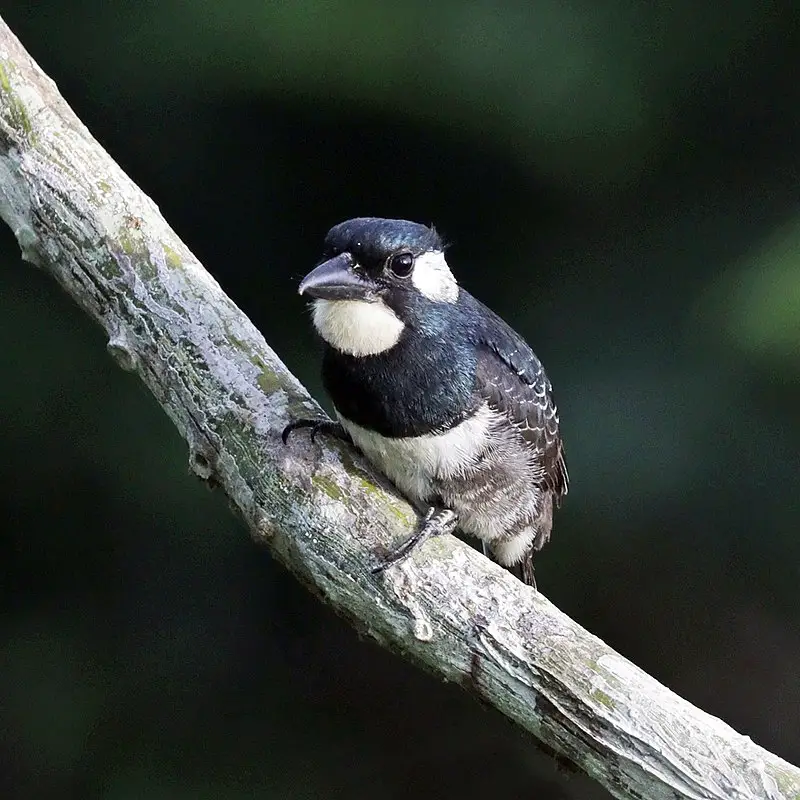
The black-breasted puffbird is a species of bird found in Colombia, Ecuador and Panama. It has no subspecies, but it is closely related to the brown-banded puffbird.
This medium sized avian measures around 19–20 cm long with distinctive greyish plumage and white underparts that are marked by dark streaks or bars on its breast.
Its most recognizable features include an orange forehead patch and yellow eye rim as well as blue legs and feet.
The male also displays two bright red wattles along his cheeks during courtship rituals which occur at their nesting sites near rivers or streams within humid forest habitats where they feed mainly on insects such as beetles, grasshoppers, flies etc., using their stout bills for catching prey.Scientific classification:
| Kingdom | Animalia |
| Phylum | Chordata |
| Class | Aves |
| Order | Piciformes |
| Family | Bucconidae |
| Genus | Notharchus |
| Species | N. pectoralis |
31. Brown-Billed Scythebill
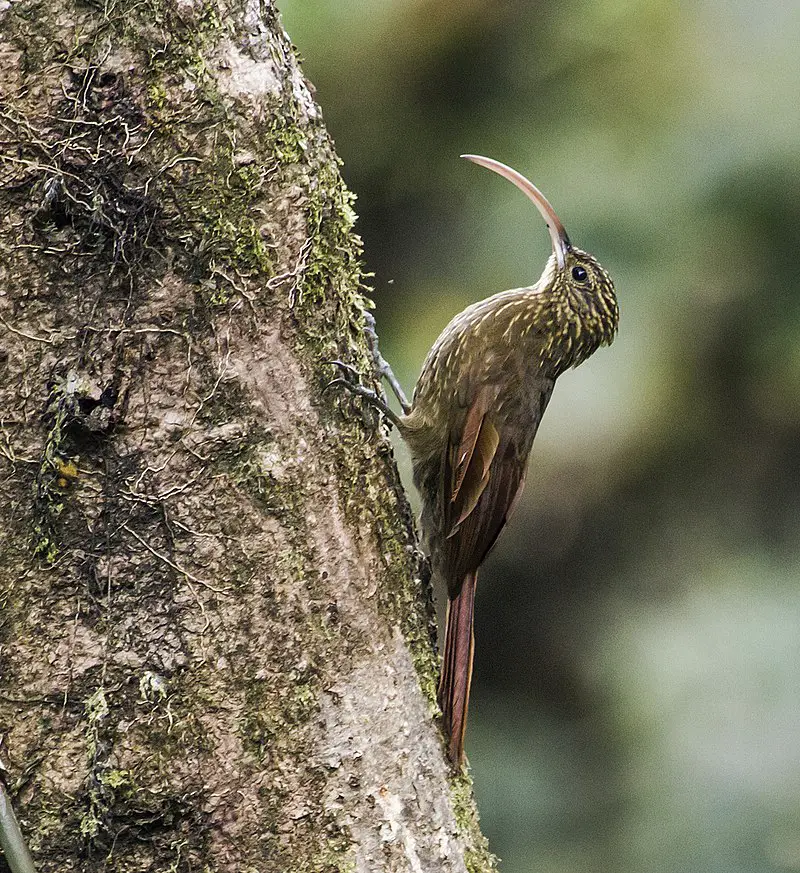
The Brown-billed Scythebill is a species of bird belonging to the Furnariidae family. It can be found in Colombia, Costa Rica, Ecuador, Panama, Peru and Venezuela living in subtropical or tropical moist lowland and montane forests.
This small bird has brown feathers with white spots on its wings as well as bright yellow eyes. Its long bill curves downwards which gives it its unique name.
The diet of this species consists mainly of insects but also includes some fruit foraged from trees or bushes near their nests where they lay two eggs at once before incubating them for about 17 days until hatching occurs.
They are overall quite peaceful birds yet will defend their territory fiercely if necessary making loud calls while doing so.Scientific classification:
| Kingdom | Animalia |
| Phylum | Chordata |
| Class | Aves |
| Order | Passeriformes |
| Family | Furnariidae |
| Genus | Campylorhamphus |
| Species | C. pusillus |
32. Black-Tailed Trogon
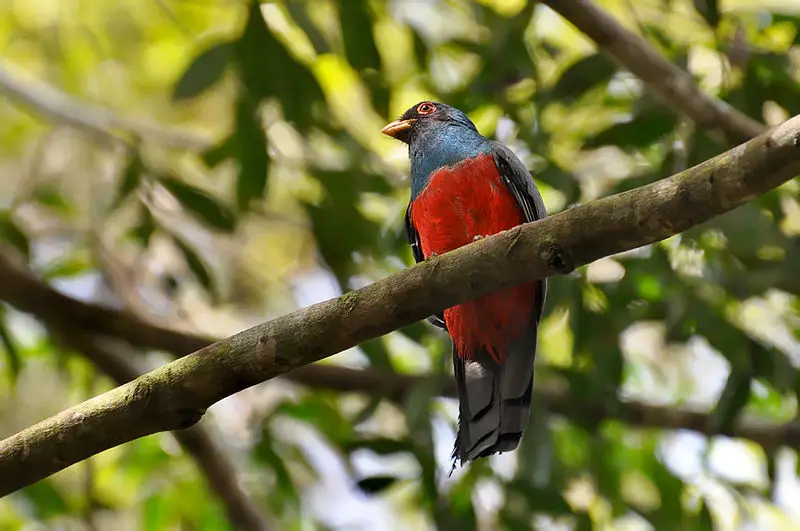
The Black-tailed Trogon is a beautiful species of bird found in Panama and northern South America. It belongs to the family Trogonidae, which also includes quetzals and trogons.
The nominate subspecies T. m. melanurus has glossy black plumage on its back, white underparts with grey barring along its sides, a yellow bill and eye ring as well as red undertail coverts that give it its name.
Its two other subspecies are the T. m macroura with brownish upper parts and buff breast banding; while T eumorphus has rufous crowns paired with blue green wing patches instead of the usual red ones seen in others members of this species group.
Additionally, Clements taxonomy adds another fourth subspecies:T occidentalis – darker than all previous forms but still possessing some distinctive coloration pattern elements from them.
All these variations make for an interesting sight when observed up close.Scientific classification:
| Kingdom | Animalia |
| Phylum | Chordata |
| Class | Aves |
| Order | Trogoniformes |
| Family | Trogonidae |
| Genus | Trogon |
| Species | T. melanurus |
33. Black-Capped Pygmy Tyrant
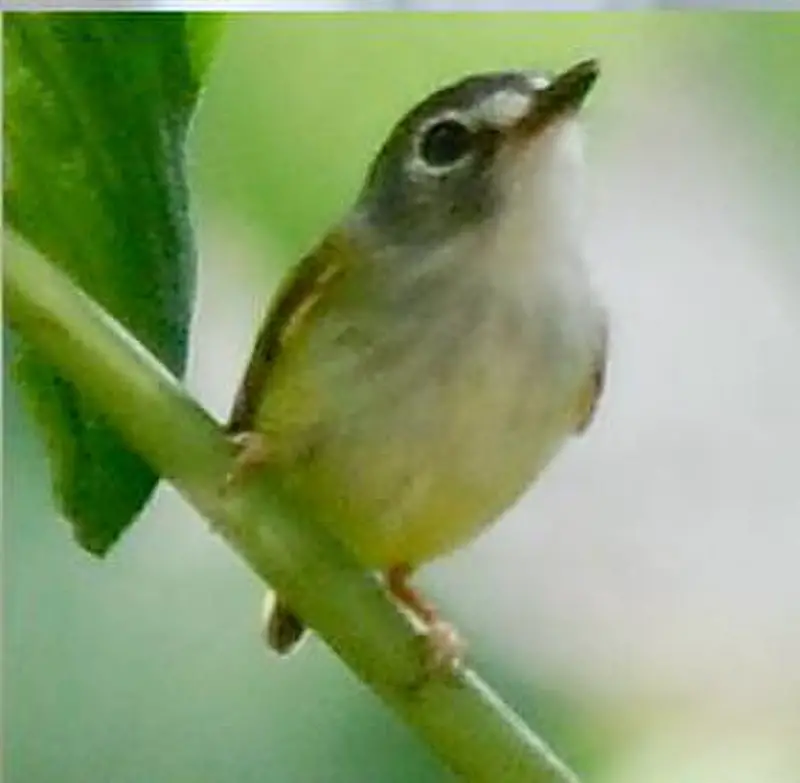
The Black-capped Pygmy Tyrant is the smallest passerine bird in its range, living from Costa Rica to north-western Ecuador. It resides mainly within forest canopy at altitudes up to 900 meters and will occasionally come down into edges and clearings of second growth or semi-open woodland.
This tyrant flycatcher has an olive green upper body, black cap with white throat patch, yellowish belly and pale gray wings with two buff bars on each feather. The adult male’s bill is bright orange while that of the female is brownish grey.
These birds usually feed on small insects such as flies caught by short flights out from a perch or hawked directly from tree foliage.
They are often seen in pairs but sometimes form small family groups consisting of parents and their offspring when breeding season comes around.Scientific classification:
| Kingdom | Animalia |
| Phylum | Chordata |
| Class | Aves |
| Order | Passeriformes |
| Family | Tyrannidae |
| Genus | Myiornis |
| Species | M. atricapillus |
34. Blue-And-Yellow Macaw
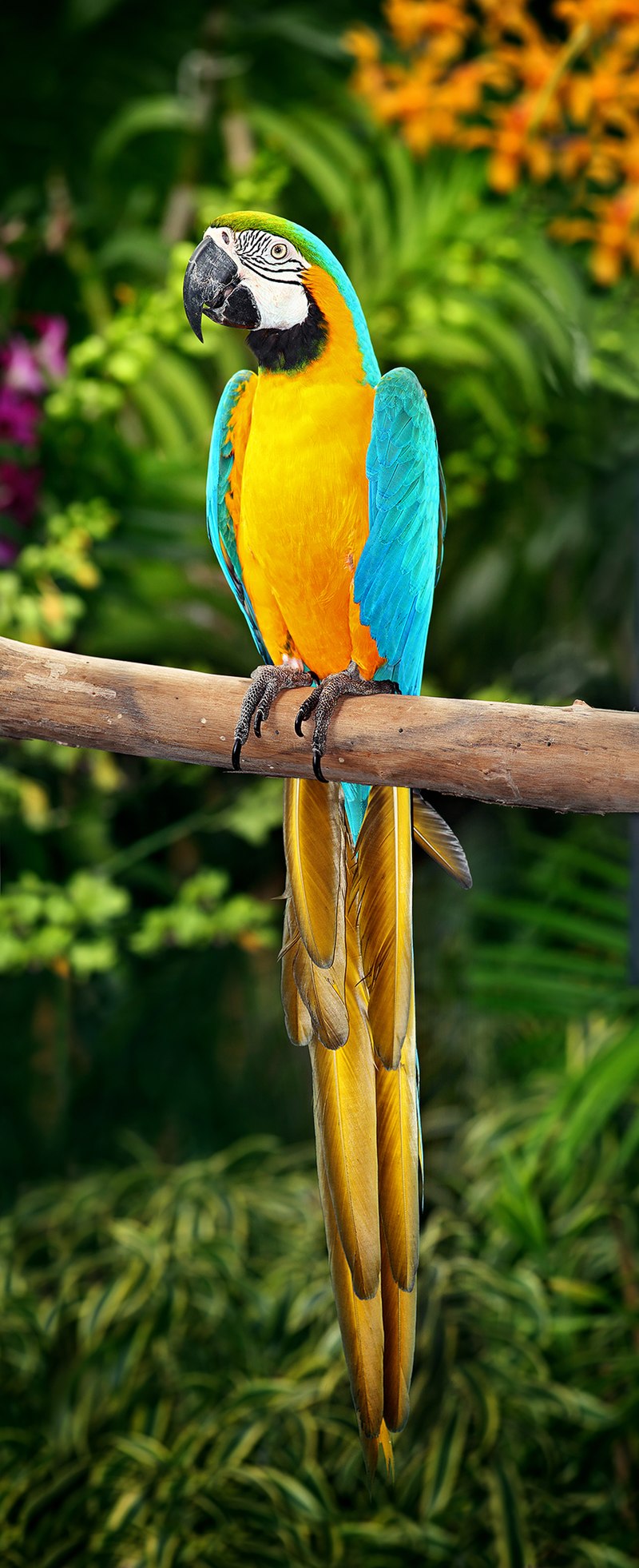
The Blue-and-yellow Macaw is a vibrant and eye catching bird native to South America. It has beautiful blue top parts, light orange underparts, and green on its head.
This large parrot lives in the tropical forests of varzea, terra firme or unflooded forest areas.
They are social birds that live in small flocks which can range from two to twenty birds during breeding season when they look for mates.
They feed mainly on seeds, nuts and fruits but sometimes also eat insects like beetles and caterpillars as well as tender shoots from trees & plants.
These macaws have an impressive call with loud screams used both to attract mates and communicate between members of their flock while flying long distances across open fields together.Scientific classification:
| Kingdom | Animalia |
| Phylum | Chordata |
| Class | Aves |
| Order | Psittaciformes |
| Family | Psittacidae |
| Genus | Ara |
| Species | A. ararauna |
35. Blue-Headed Parrot
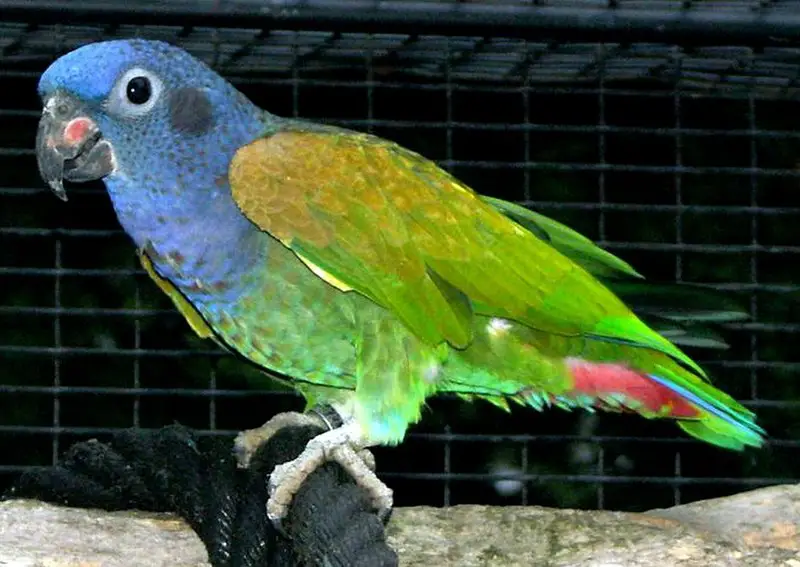
The Blue-headed Parrot is a stunning bird native to South and Central America. It measures around 27 cm in length, with its body mostly green, blue head and neck, and red undertail coverts.
This beautiful parrot lives in tropical or subtropical forests as well as savannas where it feeds on fruits such as figs, nuts and mangos.
In the wild they are often seen flying in small groups of up to 10 birds that chatter loudly.
They make excellent pets too due to their intelligence but require lots of attention from owners who should provide plenty of toys for them so they don’t get bored.
All in all these amazing creatures will bring joy into any home or garden.Scientific classification:
| Kingdom | Animalia |
| Phylum | Chordata |
| Class | Aves |
| Order | Psittaciformes |
| Family | Psittacidae |
| Genus | Pionus |
| Species | P. menstruus |
Also Featured In: Blue Birds You’ll Found around Us, Case Birds that Live in with Us
36. Clay-Colored Thrush
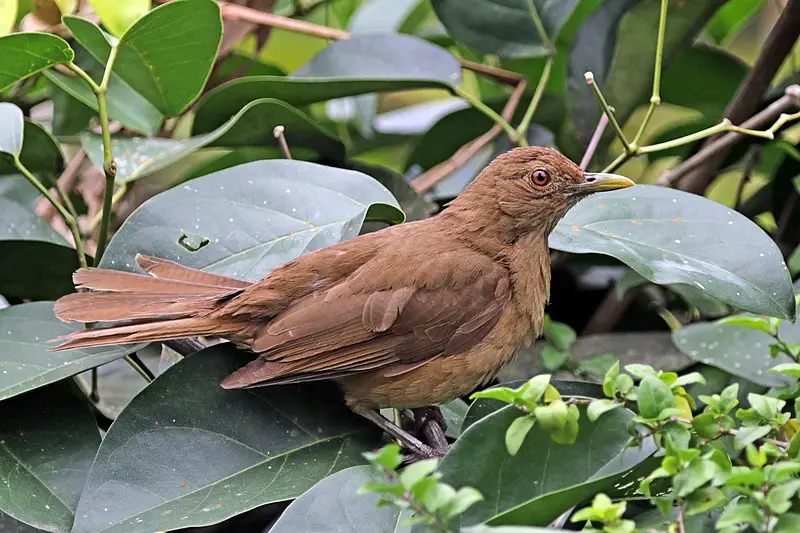
The Clay-colored Thrush is a common Middle American bird belonging to the thrush family. It has become known as Costa Rica’s national bird, going by the name yigüirro in Spanish.
Not only does it inhabit South Texas and parts of northern Colombia, but its range extends westward and northward from Isthmus Tehuantepec too.
It has an overall buffy coloration with brownish upperparts which help distinguish this species from other birds within its habitat.
Additionally, some individuals have white tips on their tail feathers that further serve to differentiate them amongst others of their kind.
This hardy species continues to thrive in many different habitats across Central America making it one of the most widespread songbirds around.Scientific classification:
| Kingdom | Animalia |
| Phylum | Chordata |
| Class | Aves |
| Order | Passeriformes |
| Family | Turdidae |
| Genus | Turdus |
| Species | T. grayi |
37. Black-Chested Jay
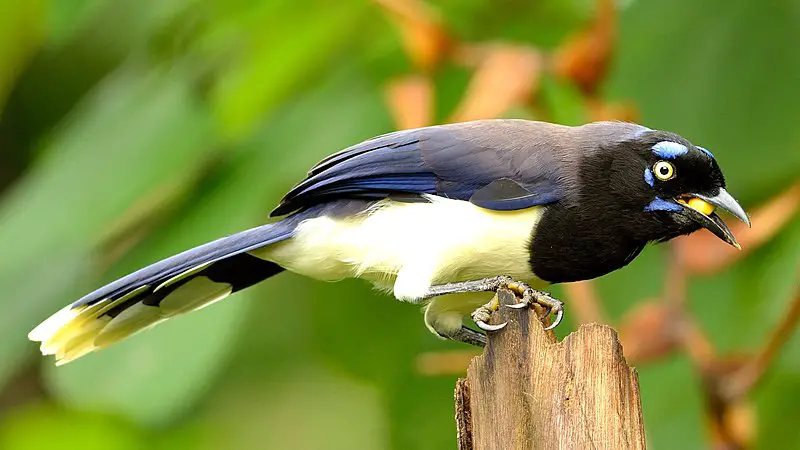
The Black-chested Jay is a beautiful bird with a unique and distinct facial pattern. It measures around 34 cm (13 in) long, with its head, face, chest being mostly black and violet-blue spots above and below the eye as well as along the malar stripe.
Its underparts are white while its upperparts are grayish blue to olive green. This species of jay also has yellow eyes that stand out against their black feathers giving it an even more captivating look.
It mainly feeds on fruits, insects and small animals like lizards or frogs which they hunt for near streams or rivers.
They usually form pairs during breeding season but can be found living in groups throughout other times of year too.Scientific classification:
| Kingdom | Animalia |
| Phylum | Chordata |
| Class | Aves |
| Order | Passeriformes |
| Family | Corvidae |
| Genus | Cyanocorax |
| Species | C. affinis |
38. Black-Striped Sparrow
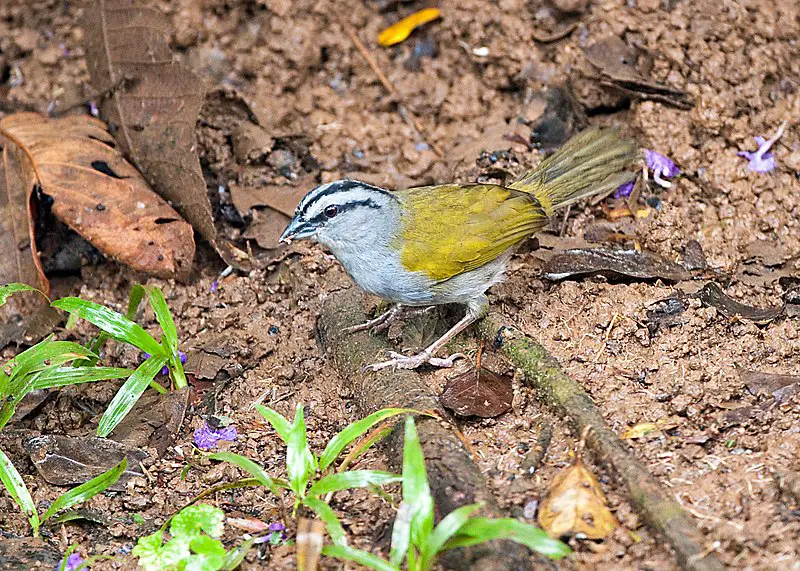
The black-striped sparrow is a passerine bird found in Central and South America, ranging from Honduras to Ecuador. This common species inhabits humid lowlands and foothills up to 1,500 m (4,900 ft) high.
It can be spotted near semiopen habitats such as thickets, young second growths, overgrown fields or shady plantations.
The large domed nests are built by the female using straws and grasses held together with spider webs; they usually have one entrance placed at the side of the nest.
These birds feed on small insects like beetles or caterpillars which they find among leaf litter on trees or shrubs – but also eat fruits when available.
They flock around rivers for bathing during warmer weather too.Scientific classification:
| Kingdom | Animalia |
| Phylum | Chordata |
| Class | Aves |
| Order | Passeriformes |
| Family | Passerellidae |
| Genus | Arremonops |
| Species | A. conirostris |
39. Chestnut-Fronted Macaw
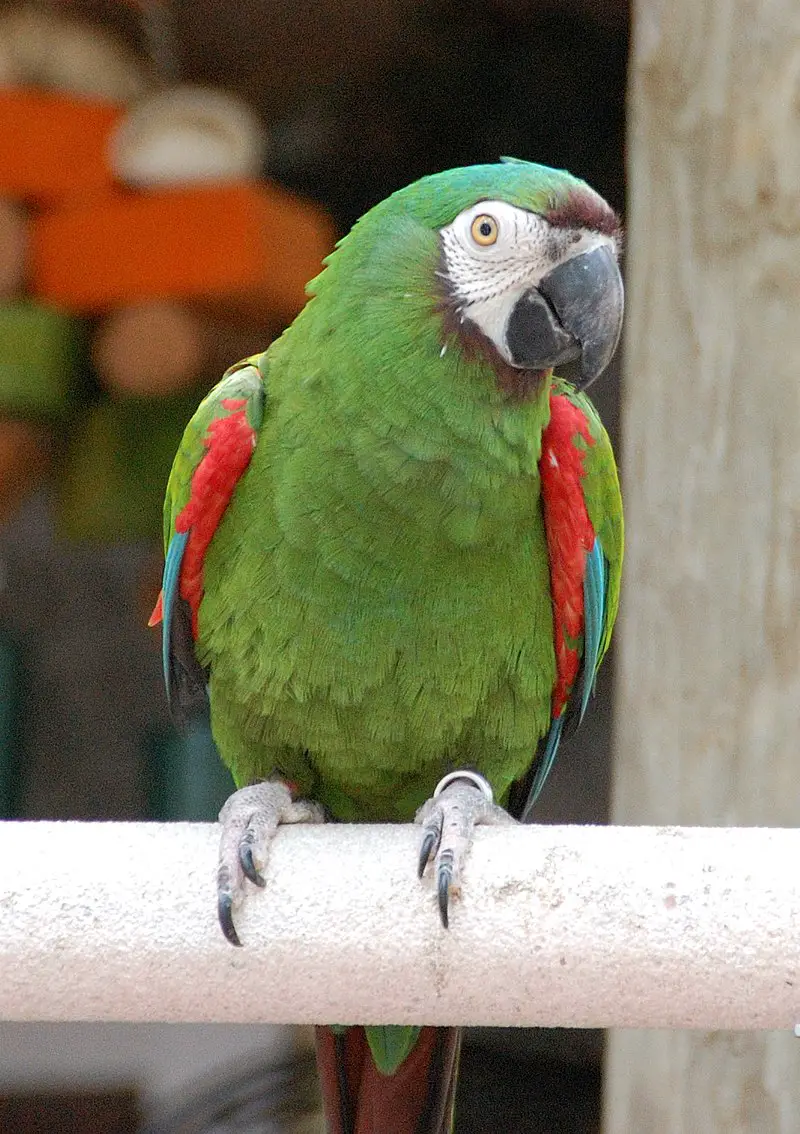
The Chestnut-fronted Macaw, also known as the Severe Macaw, is a mini-macaw species native to Northern South America.
They are considered one of the largest macaws and typically reach 18 inches in length with half of that being from their tail.
These beautiful birds can be found stretching from Panama down into Brazil and Bolivia while they have even established a feral population in Florida.
With an expected lifespan ranging anywhere between 30 to 50 years these exotic beauties make for quite endearing companions if properly taken care of.
For those looking for interesting conversation pieces or feathered friends this may just be your perfect choice.Scientific classification:
| Kingdom | Animalia |
| Phylum | Chordata |
| Class | Aves |
| Order | Psittaciformes |
| Family | Psittacidae |
| Genus | Ara |
| Species | A. severus |
Also Featured In: Green Birds Commonly Found in Florida,
40. Pharomachrus
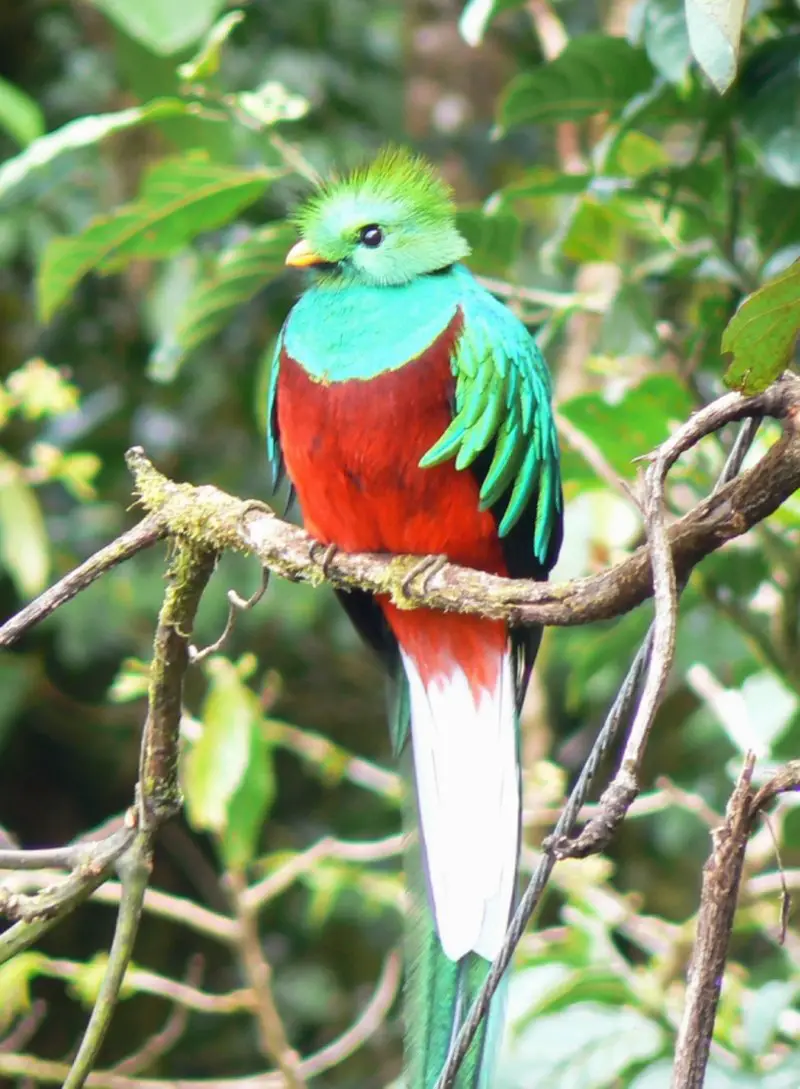
Pharomachrus is a genus of birds belonging to the Trogonidae family. These strikingly colorful creatures are commonly known as quetzals, and comprise of five species in this single genus.
Its name originates from Ancient Greek words ‘pharos’ meaning mantle, and ‘makros’ which means long – referring to its wing coverts that appear like mantles when fully spread out.
The Eared Quetzal is the only surviving member of the related but distinct Genus Euptilotis, making it one among these six beautiful avian jewels found mostly in Central America and parts of Southwestern North America.Scientific classification:
| Kingdom | Animalia |
| Phylum | Chordata |
| Class | Aves |
| Order | Trogoniformes |
| Family | Trogonidae |
| Genus | Pharomachrus de la Llave, 1832 |
41. Common Tody-Flycatcher
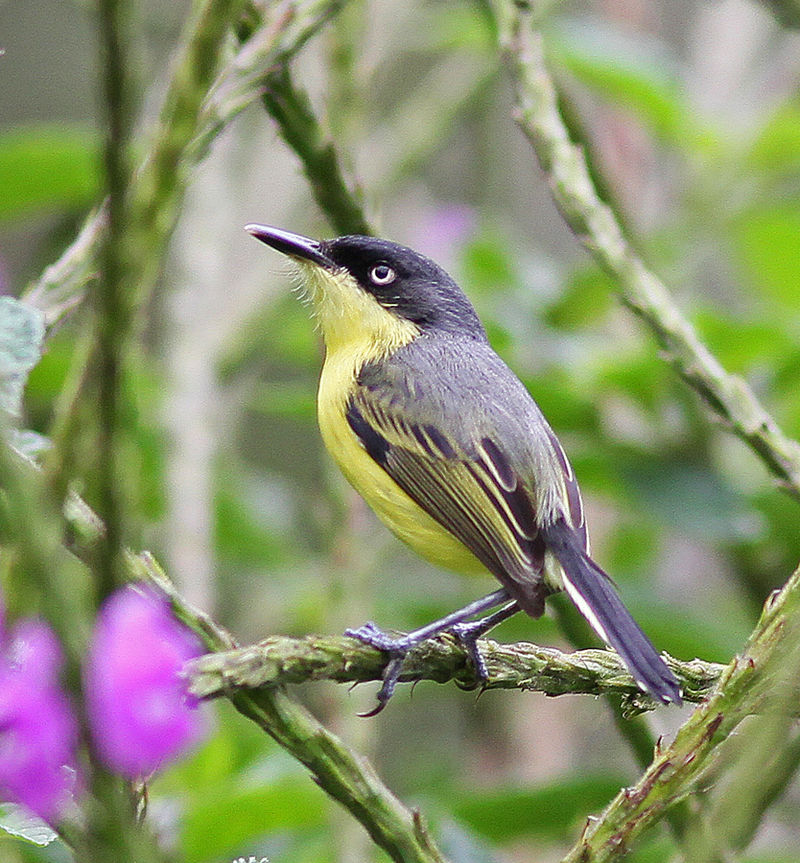
The Common Tody-flycatcher is a vibrant little bird, which belongs to the tyrant flycatcher family.
It inhabits parts of Mexico and South America, ranging from southern Mexico right down to Northwestern Peru, Eastern Bolivia and parts of Brazil.
These birds have beautifully coloured plumage that consists mainly of olive green on their back with white bellies; they also sport black heads with yellow crowns and rufous throats.
They are incredibly small in size – measuring between 10cm – 12 cm long – but make up for it by being highly active during flight as well as vocal.
Their call sounds like “todi” or “tee-dee”. As insectivores these birds feed primarily off insects such as moths, crickets and spiders amongst others found within trees where they usually nest in cavities or crevices close to the tree trunk.Scientific classification:
| Kingdom | Animalia |
| Phylum | Chordata |
| Class | Aves |
| Order | Passeriformes |
| Family | Tyrannidae |
| Genus | Todirostrum |
| Species | T. cinereum |
42. Silver-Throated Tanager
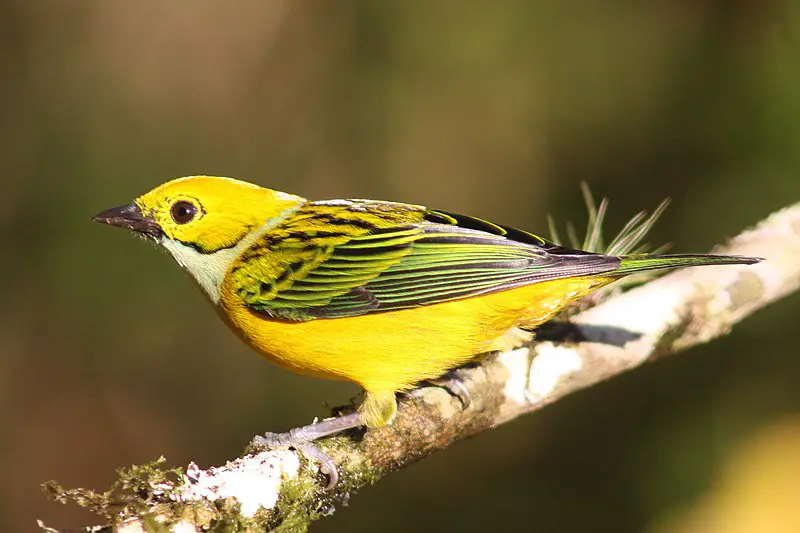
The magnificent silver-throated tanager is a species of passerine bird in the Thraupidae family.
It occupies parts of Costa Rica, Panama, Colombia, Ecuador and Peru where it prefers to live in mossy forests with tall secondary growth or disturbed habitats that still have some remnant trees.
Standing at an impressive 13 cm long this colourful creature has a beautiful mixture of blue feathers on its head and neck as well as yellowish green wings tipped with white.
Its underparts are grey while its tail is black fringed with olive-green highlights which adds to its striking appearance.
In addition they also sport bright red eyes which further enhance their beauty making them one of nature’s most exquisite birds.Scientific classification:
| Kingdom | Animalia |
| Phylum | Chordata |
| Class | Aves |
| Order | Passeriformes |
| Family | Thraupidae |
| Genus | Tangara |
| Species | T. icterocephala |
Also Featured In: Silver Birds You Should Know,
43. Semiplumbeous Hawk
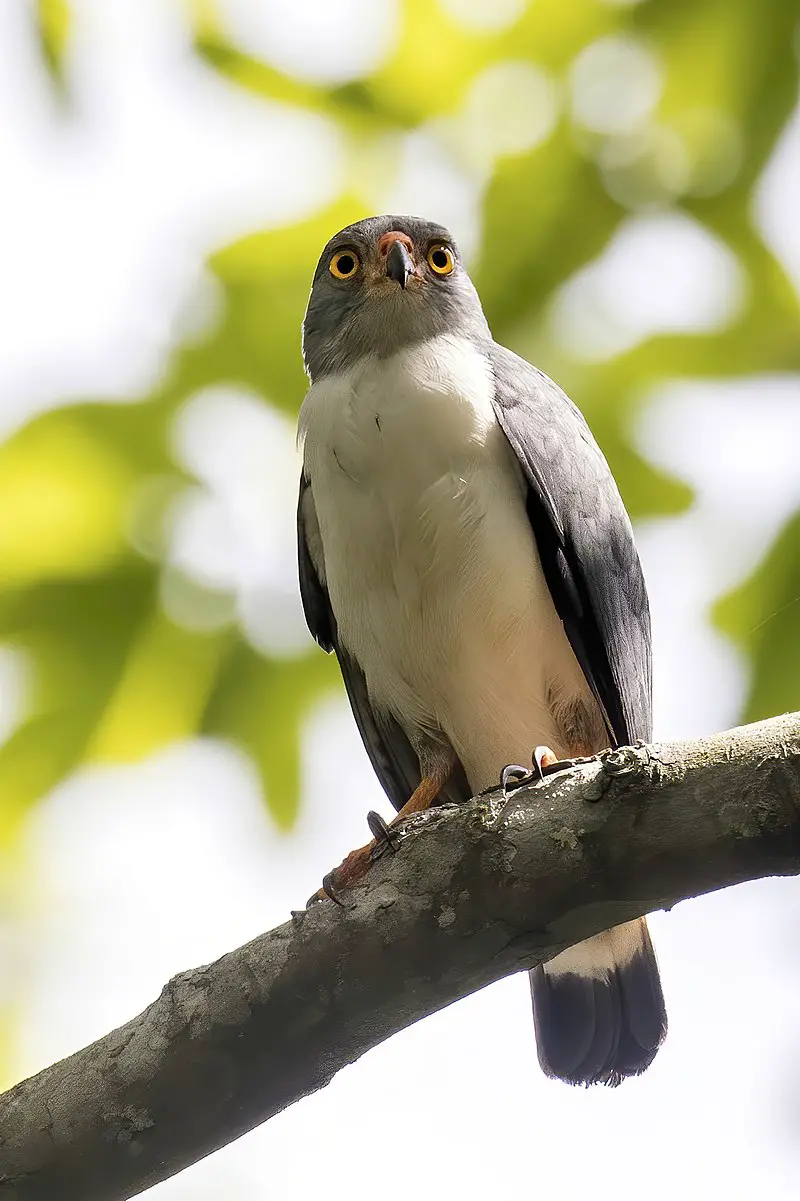
The Semiplumbeous Hawk is a small bird of prey typically found in the forests and woodlands of Central America.
It measures approximately 12-13 inches long, making it about the size of a kestrel or merlin.
This species has dark grey plumage on its wings, back and head with white streaks along its chest giving it an overall speckled appearance.
Its tail is barred black and white underneath with two broad black bands at the tip.
The beak is yellowish orange while legs are usually light coloured or greenish yellow.
These birds feed mainly on reptiles, amphibians and rodents but will also take insects as they hunt from perches within their habitat such as trees or bushes.
Despite being quite uncommon to spot due to their smaller size they have adapted well to human presence so can often coexist peacefully near urban areas if there are appropriate natural habitats nearby for them to nest in.Scientific classification:
| Kingdom | Animalia |
| Phylum | Chordata |
| Class | Aves |
| Order | Accipitriformes |
| Family | Accipitridae |
| Genus | Leucopternis |
| Species | L. semiplumbeus |
44. Slaty-Backed Forest Falcon
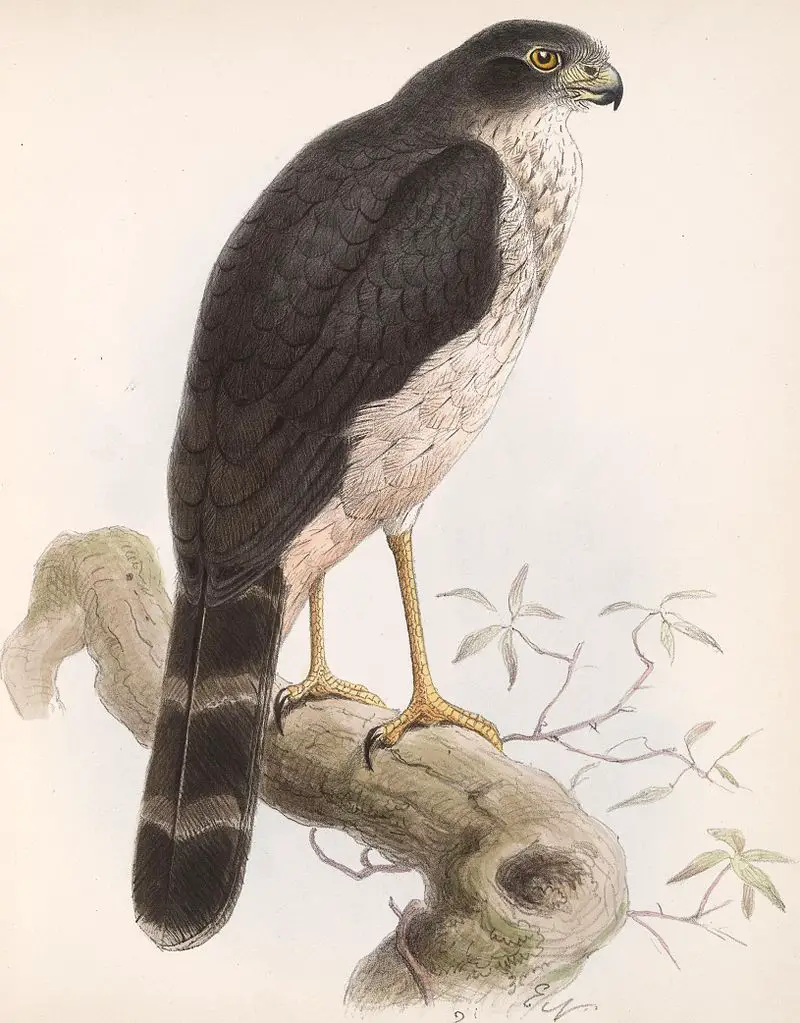
The Slaty-backed forest falcon is a majestic bird of prey found in many parts of Central and South America. The species has been identified by its mottled grey plumage, which provides excellent camouflage against the dark shadows of the forests it inhabits.
It is an active hunter, using its sharp eyesight to spot potential meals from far away – these can range from birds and snakes to lizards, rodents and even bats.
Its diet also includes some fish on occasion. This incredible raptor plays an important role in keeping balance within local ecosystems.
However as with most other wildlife populations around the world, their numbers are decreasing due to deforestation and human activities such as hunting for sport or food.
Conservation efforts must be taken if this remarkable species is to survive into future generations.Scientific classification:
| Kingdom | Animalia |
| Phylum | Chordata |
| Class | Aves |
| Order | Falconiformes |
| Family | Falconidae |
| Genus | Micrastur |
| Species | M. mirandollei |
45. Tawny-Capped Euphonia
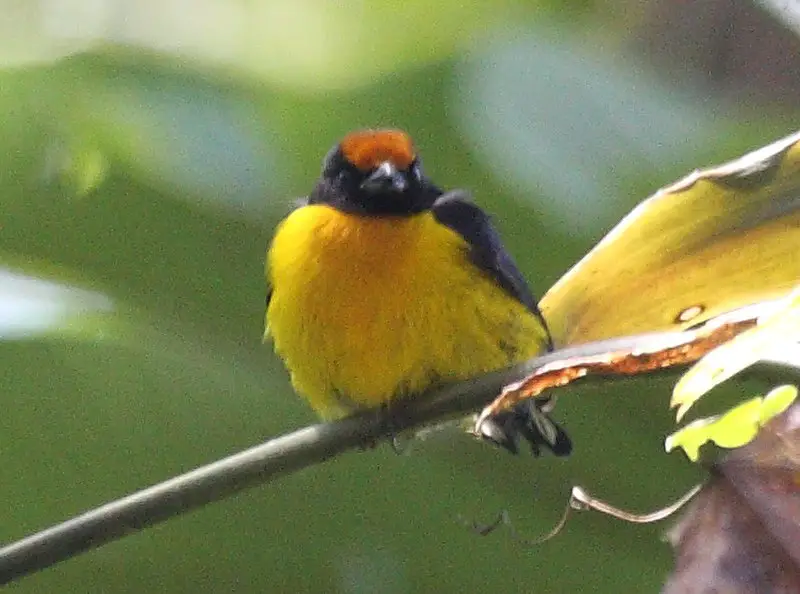
The Tawny-capped Euphonia is a small colourful bird that can be found in the tropical regions of Colombia, Costa Rica and Panama. Its feathers are bright yellow on its head, neck and chest with black wings and tail.
It has an overall tawny brown coloration to it’s crown which gives it its name. This species lives mainly in lowland forests but also inhabits heavily degraded former forest areas as well as some montane forests.
They feed primarily on insects such as caterpillars and beetles which they catch by foraging through foliage or hovering over vegetation while searching for prey items.
Their diet may also include other types of arthropods from time to time including spiders, centipedes, millipedes and even ants.
These birds live in pairs or family groups during most months except when breeding season occurs at which point they gather into large flocks that range anywhere between 10-50 individuals each flock.
All these behaviors make them delightful creatures to watch out for if you ever come across one.Scientific classification:
| Kingdom | Animalia |
| Phylum | Chordata |
| Class | Aves |
| Order | Passeriformes |
| Family | Fringillidae |
| Subfamily | Euphoniinae |
| Genus | Euphonia |
| Species | E. anneae |
46. Rufescent Tiger Heron
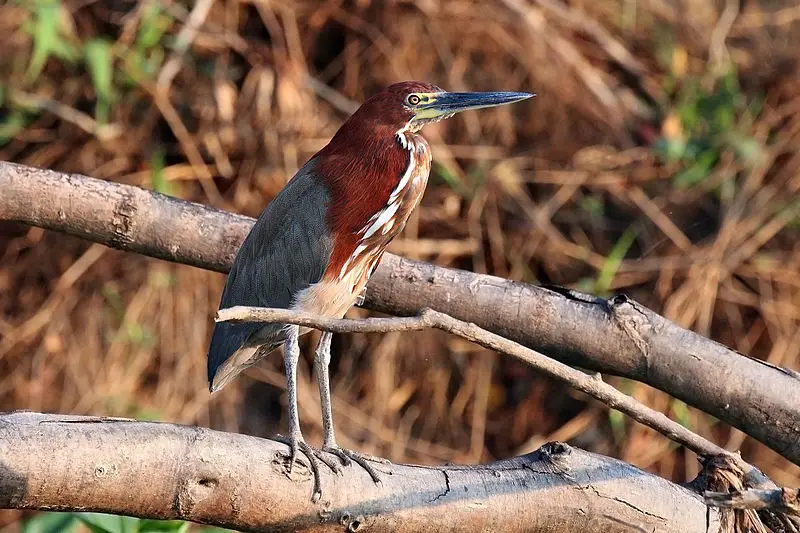
The Rufescent Tiger Heron is a species of heron found in wetlands from Central America to South America. It was first described by the French polymath Georges-Louis Leclerc, Comte de Buffon in 1780.
This majestic bird has a light brown body with dark barring on its wings and tail feathers. Its long beak curves downwards and its legs are yellowish-green.
The head is grayer than the rest of its body, giving it an almost regal appearance when seen in flight or perching atop trees near water bodies like rivers or lakes.
With their striking colours and size – reaching up to 90cm tall – they can easily stand out against other birds.Scientific classification:
| Kingdom | Animalia |
| Phylum | Chordata |
| Class | Aves |
| Order | Pelecaniformes |
| Family | Ardeidae |
| Genus | Tigrisoma |
| Species | T. lineatum |
47. Golden-Hooded Tanager
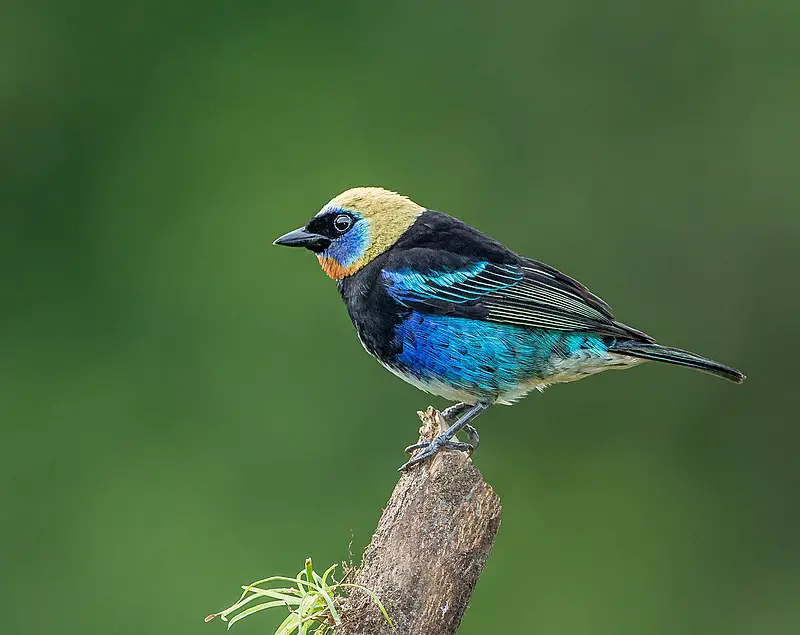
The Golden-hooded Tanager is a medium sized passerine bird, found in central and South America. It has an impressive appearance with its golden head, black eyemask edged with violet blue above and below, as well as turquoise shoulders.
These birds measure 13 cm long and weigh 19 g on average.
They are known to be resident breeders from Mexico down to western Ecuador where they can often be seen gathering around fruiting trees or shrubs searching for food such as berries and small insects.
The males often aggressively defend their territories against other intruders during breeding season which usually occurs between April – August when the female will lay 2-3 white eggs in a cup nest built high up near tree branches by both parents. These bright little birds make great additions to any backyard aviary.Scientific classification:
| Kingdom | Animalia |
| Phylum | Chordata |
| Class | Aves |
| Order | Passeriformes |
| Family | Thraupidae |
| Genus | Stilpnia |
| Species | S. larvata |
48. Great Potoo
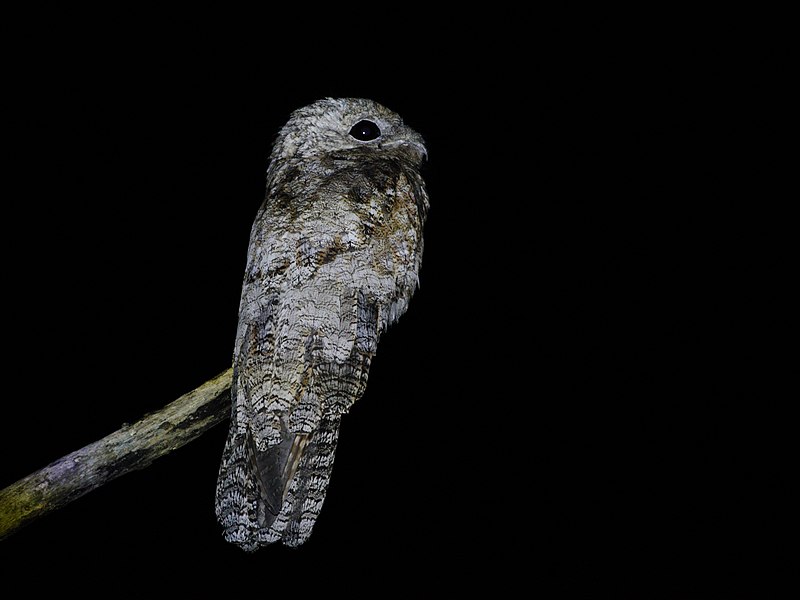
The Great Potoo is a nocturnal bird that can be found in Central and South America. It has unique plumage, with its grey-brown body against white feathers on the underside of it’s wings.
Its head also features yellow eyes, long eyelashes and an impressive crest atop its crown.
This species preys upon large insects as well as small vertebrates which they catch by making short sallies from their high perches at night time.
The most recognisable trait of this bird however is the melodic moaning growl it vocalizes throughout the night – creating an eerie atmosphere in any location where they are present.Scientific classification:
| Kingdom | Animalia |
| Phylum | Chordata |
| Class | Aves |
| Order | Nyctibiiformes |
| Family | Nyctibiidae |
| Genus | Nyctibius |
| Species | N. grandis |
Also Featured In: Birds You’ll Find in Night,
49. Common Potoo
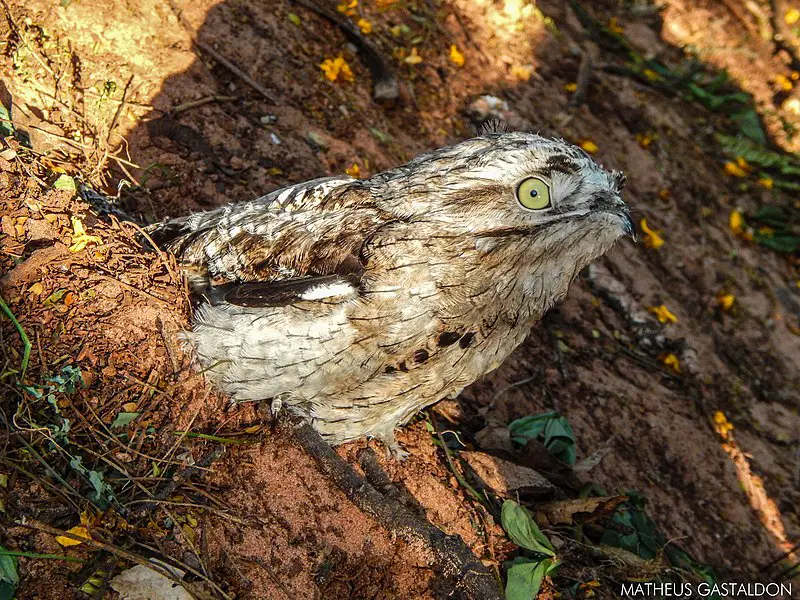
The Common Potoo is an intriguing species of bird, belonging to the Nyctibius genus and related to nightjars and frogmouths. It has large yellow eyes that stand out in its wide open mouth, giving it a comical look.
This nocturnal creature lives mainly in Central America but can also be found as far south as Argentina.
Its feathers are typically dark brown or grey with white markings on its neck and wings providing camouflage during the day when they roost motionless amongst tree branches.
The call of this mysterious bird is described as a loud whistle which rises from low-pitched “poor me” notes towards higher pitched ones at dawn and dusk – hence why it’s commonly known as ‘Poor Me Ones’.Scientific classification:
| Kingdom | Animalia |
| Phylum | Chordata |
| Class | Aves |
| Order | Nyctibiiformes |
| Family | Nyctibiidae |
| Genus | Nyctibius |
| Species | N. griseus |
50. Cocoa Woodcreeper
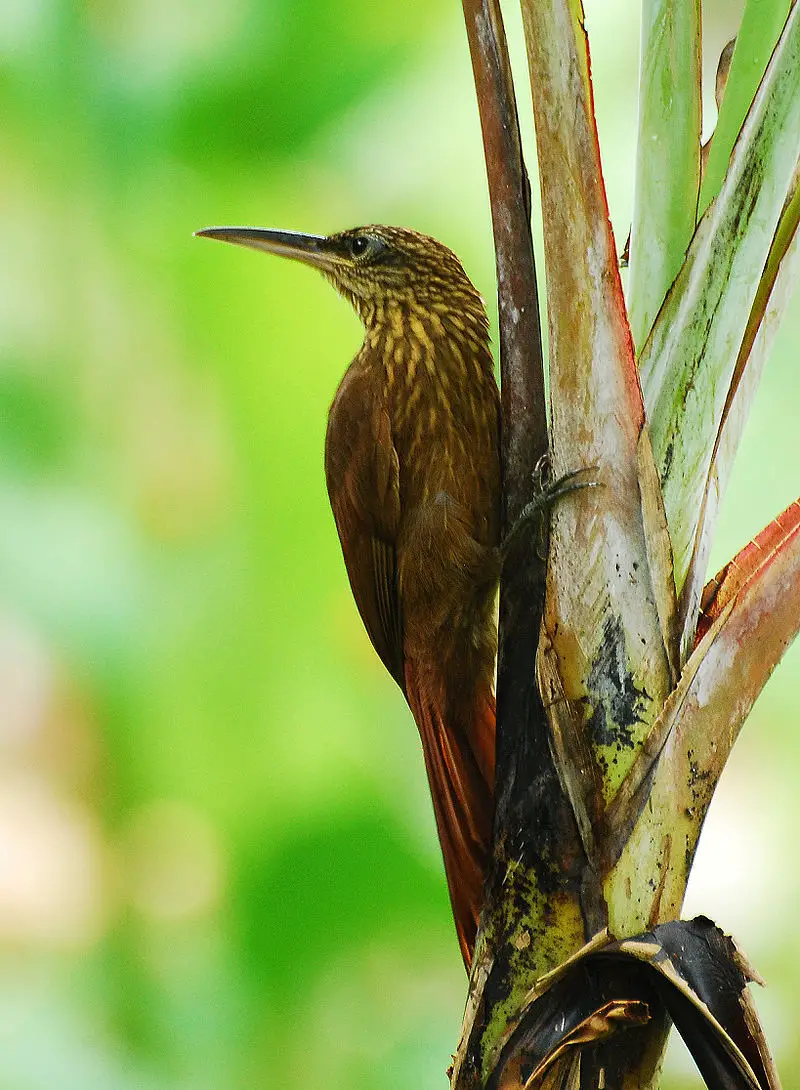
The Cocoa Woodcreeper is a passerine bird belonging to the woodcreeper subfamily of the ovenbird family.
It typically measures 23 cm in length and weighs 37 g, with its head and neck being buff-streaked dark brown, upper back liver-brown, wings rufous and tail also rufous.
The underparts are creamy white or yellowish white streaked with darker colors. Its bill is slightly decurved and black on top while grey underneath.
This species can be found mainly in Central America from southern Mexico to Panama as well as northern South America including Colombia, Venezuela, Ecuador etc., inhabiting humid lowland forests up to 2000 m elevation range.
They feed by searching for insects on tree trunks or bark flaking off trees using their long bills which make them good climbers too.Scientific classification:
| Kingdom | Animalia |
| Phylum | Chordata |
| Class | Aves |
| Order | Passeriformes |
| Family | Furnariidae |
| Genus | Xiphorhynchus |
| Species | X. susurrans |